The following is a translation of an interview with our Chief Game Designer Hideki Kamiya and his younger brother, originally run on Famitsu.com in December of 2017. https://www.famitsu.com/
Growing Up with Games: A Talk with the Kamiya Brothers Part 2
By Keigo Toyoda
Last week we heard from PlatinumGames’ own chief game designer Hideki Kamiya and his younger brother about what it was like to grow up while video games were just starting to flourish. This time, we’ll hear about PC gaming, thoughts on classic gaming, and a host of fun anecdotes as the talk with the brothers continues.
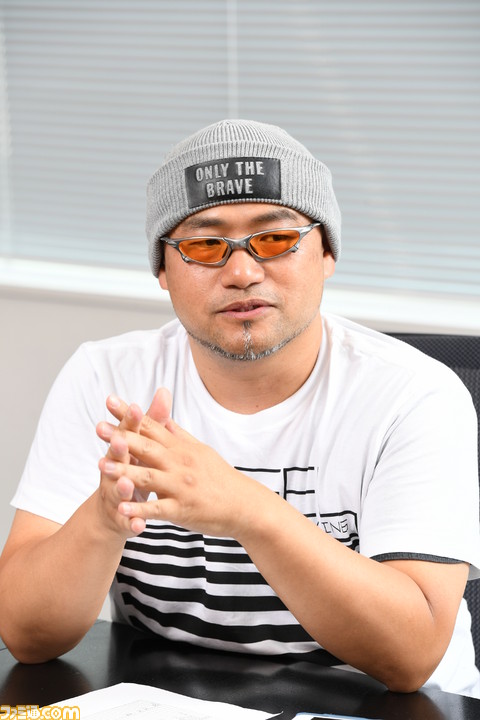
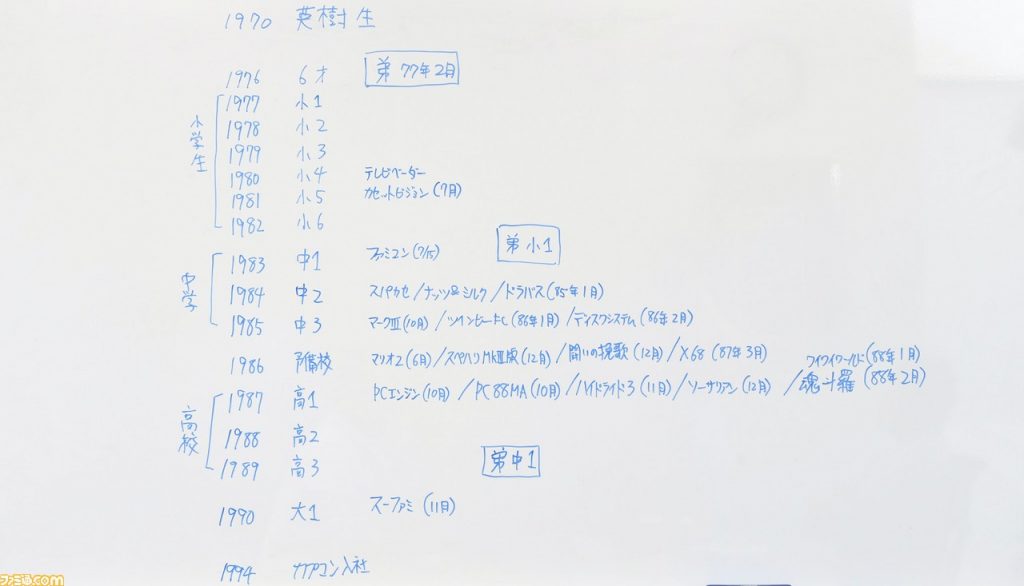 A timeline handwritten by Hideki Kamiya. It will be a point of reference throughout the interview.
A timeline handwritten by Hideki Kamiya. It will be a point of reference throughout the interview.
| Year | Event |
| 1970 | Hideki Kamiya born |
| 1976: Age 6 | |
| 1977: Elementary school, 1st grade | (younger Kamiya born February 1977) |
| 1978: Elementary school, 2nd grade | |
| 1979: Elementary school, 3rd grade | |
| 1980: Elementary school, 4th grade | |
| 1981: Elementary school, 5th grade | |
| 1982: Elementary school, 6th grade | |
| 1983: Junior high, 7th grade | NES (7/15) (YK, elementary 1st grade) |
| 1984: Junior high, 8th grade | Super Cassette Vision, Nuts & Milk, Dragon Buster (January 1985) |
| 1985: Junior high, 9th grade | Master System (October), Twinbee NES (January 1986), Disc System (February 1986) |
| 1986: Cram school | Super Mario Bros: The Lost Levels (June), Space Harrier (Master System, December), Trojan (December), X68000 (March 1987) |
| 1987: High school 10th grade | TurboGrafix-16 (October), PC88MA (October), Hydlide 3 (November), Sorcerian (December), Contra (February 88) |
| 1988: High school 11th grade | |
| 1989: High school 12th grade | (YK junior high 7th grade) |
| 1990: University 1st year | SNES (November) |
| 1994: Started at Capcom |
Toyoda: When you started playing PC games, what kind of games did you play? We’re talking about 5 inch floppies (*1), right?
*1: Officially known as 5.25 inch disks, 5 inch floppies had write protection stickers applied to the outer notches to protect the disk from being overwritten.
HK: Right. I wrote “PC-8801MA-October” (*2) on the white board, but I realized that I actually bought it toward the end of the year. I bought it together with Hydlide 3 (*3), so it would have been November or later. I had my dad promise to buy me a PC when I got into high school, but when he heard the price he said, “There’s no way I’m buying that!” and reneged. (Laughs) I did part time work and saved up about 200.000 yen. What I really wanted was an X68000 (*4), but the machine we used in my school’s data processing class was the PC-8801. I convinced my parents that since it was the same as what we were using in school, I could use it to study and they put in the rest of the money I needed to buy the PC-8801MA. It was a compromise on both parts. (Laughs) I bought Hydlide 3 in secret and hid it in my dresser for a while.
*2: The PC-8801MA was a personal computer in the PC88 series sold by NEC in 1987. At the time, it cost 198,000 yen.
*3: Hydelide 3 is an action RPG that was released by T&E Soft (currently D Wonderland Inc.) in 1987 for the PC-8801MkIISR and later machines. In addition to significant graphical and audio improvements over the previous entry, it added several realistic systems like the passage of time, hunger, sleep, and weight.
*4: The X68000 is a personal computer that was released by Sharp in 1987. The name comes from the Motorola MC68000 used in the CPU. While other computers at the time were only capable of displaying 16 colors, the X68000 could display up to 65,535. The price, including the exclusive monitor, was 450,000 yen.
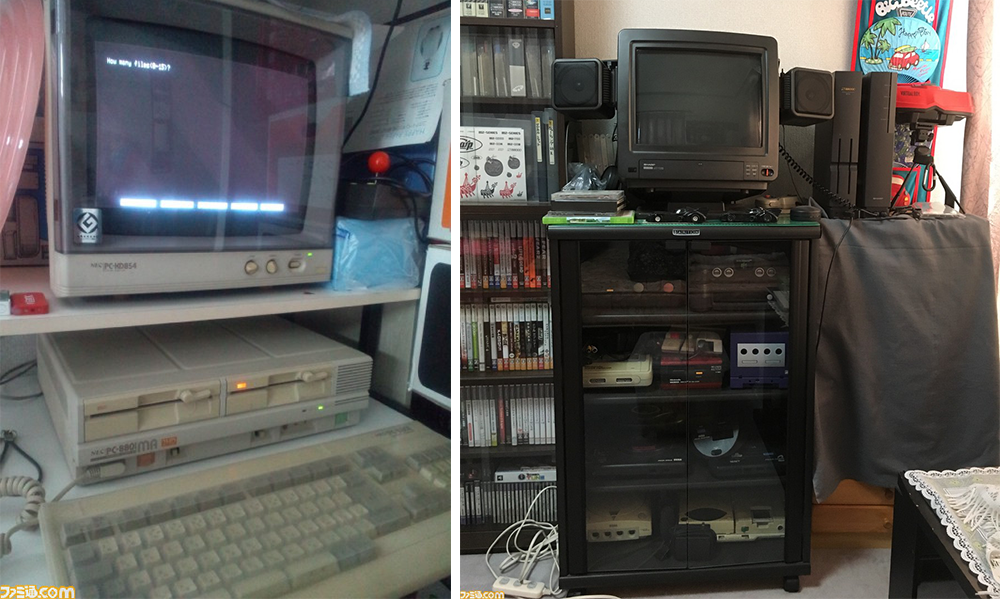
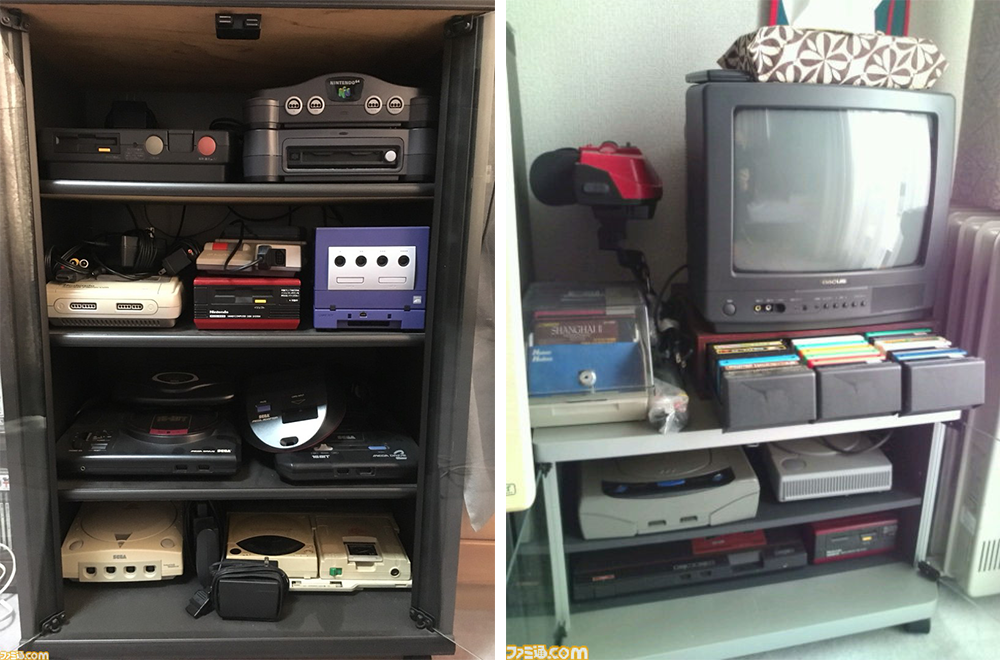 “This is my old PC-8801MA and my brother’s X68000XVI, along with several other consoles stored at our parents’ house. All of the consoles I had until leaving for university are there, and they all still work.” (Photos and comments courtesy of Hideki Kamiya)
“This is my old PC-8801MA and my brother’s X68000XVI, along with several other consoles stored at our parents’ house. All of the consoles I had until leaving for university are there, and they all still work.” (Photos and comments courtesy of Hideki Kamiya)
Toyoda: The PC-8801MA is the model with the add-on sound board, right?
HK: It had functionality in line with Sound Board 2 (*5). There weren’t a lot of games that took advantage of it so the benefits were few. Back then I didn’t even really know what “FM sound” (*6) meant, just that I’d see the PC-8801MA demo machine at Shimako on my way home from school every day, watch the demo game running and think, “Wow, FM sound is really something.” Later I took my brother to see it, and when the character on screen would walk with really realistic footsteps I’d say, “Hear that? That’s FM sound.” I found out later it wasn’t FM sound, just the Sound Board 2’s sampler. (Laughs).
*5: Sound Board 2 was the name of the expanded board used to make older PC-88 machines compatible with the additional audio functionality added to the line when the audio chip was upgraded to the YM2608, boasting 6-channel FM, 6-channel rhythm, 3-channel SSG3, and an ADPCM sampling channel.
*6: Frequency modulation allows for the creation of a variety of sounds with a unique texture not found in either actual instruments or analog synthesizers.
YK: No wonder it sounded real. (Laughs)
Toyoda: (Laughs) What motivated you to buy a PC for PC games? Did you see them in game magazines and want one, or get impressed by a friend’s PC?
HK: I read articles and ads in magazines like Beep, Comptiq, and MyCon Basic and was entranced by visuals that just weren’t possible on the NES. I still remember being fascinated by an ad for a game called Riglas (*7). The 3D-style graphics and vibrant colors felt fresh, and this was back when there were no RPGs on the NES so when I saw screens of conversations with characters I thought, “There must be tons of these new types of games on PC!” and got really excited. Also, Takagi had an X1 (*8) so there might have been some influence there. As you might be able to tell from my buying Hydlide 3 at the same time as the 8801-MA, I got into PC gaming a little later than the initial boom. After that, I bought Sorcerian (*9) and got really into PC fantasy RPGs.
*7: Riglas is an action RPG released by Random House for the PC-8801SR and compatible machines. The side view screens with a sense of depth and polished adventure elements made it very popular, and the technical prowess of the high speed side scrolling made possible by wraparound graphics was also praised.
*8: The X1 is a personal computer that was released by Sharp in 1981. At the time Sharp’s MZ series computers were designed by their electronics division, but the X1 was developed by their television division and stands out as a result. It has a “superimpose” feature that overlaps the television display and monitor, and was called a “computer television.” It’s composed of a monitor with a television tuner and keyboard.
*9: Sorcerian is an action RPG that was released by Nihon Falcom in 1987 for the PC-8801MkIISR and compatible machines. Its unique design that allowed for additional story and system expansions garnered a lot of attention.
Toyoda: It’s surprising that you went straight to Sorcerian, and not something like Dragon Slayer (*10), Xanadu (*11), or Ys (*12).
*10: Dragon Slayer is an RPG that was released by Nihon Falcom in 1984, and is one of the most famous Japanese-developed PC RPGs. The combat system is turn-based with a time limit, and players must explore dungeons, defeat dragons, and return alive with all of the crowns to win.
*11: Xanadu is an action RPG that was released by Nihon Falcom in 1985, and is the second in the Dragon Slayer series. The maps are side view, with the view changing to top down during symbol encounter battles. Battles themselves take place with individual sprites moving and attacking. The game has several unique features, such as equipment and item proficiency, giant bosses, and a “karma” system that affect progress if players kill certain enemies.
*12: Ys is an action RPG that was released by Nihon Falcom in 1987, and stands as one of the best games in PC gaming history. The beautiful FM score propelled composer Yuzo Koshiro to fame.
YK: Didn’t you play Ys after that?
HK: Yeah, Ys came afterward. I borrowed it from a friend. What game do you have fond memories of? I remember that you used to play Terra Cresta a lot.
*13: Terra Cresta is a vertically scrolling shooting game that was released by Nihon Bussan Co, Ltd. in arcades in 1985. It featured unique combination and formation attacks.
YK: On NES?
HK: No, the arcade version. You used to play at Ito Yokado all the time.
YK: I did. I remember that Dad used to leave a pile of 100 yen coins next to me while I was playing.
HK: Terra Cresta came out in October of 1985, so you would have been in 3rd grade, right?
YK: That’s right.
HK: What games do you clearly remember?
YK: Pretty much Terra Cresta and Wonder Boy: Monster Land (*14).
*14: Wonder Boy: Monster Land is an action game that was released by Sega (currently Sega Interactive) in arcades in 1987. It was full of RPG elements, like using gold gained from defeating monsters to by equipment, magic, and healing items, as well as character’s lines being displayed in text windows.
HK: Not Super Wonder Boy: Monster World (*15)? You played at the arcade?
*15: Super Wonder Boy: Monster World is a Master System port of Wonder Boy: Monster Land that was released in 1988. New stages and bosses were added.
YK: That’s right. I also played Hammerin’ Harry (*16) and Pacmania (*17) at Katakura Mall.
*16: Hammerin’ Harry is an action game that was released in arcades in 1990. Players control Harry the carpenter, who’s on a mission to hammer the greed out of the local construction company.
*17: Pacmania is a 3D version of Pac-Man that was released in arcades by Namco (currently Bandai Namco Entertainment) in 1987. It features an isometric view screen, and Pac-Man can evade the ghosts by jumping.
HK: You played Dragon Scroll (*18) on NES a lot, didn’t you?
*18: Dragon Scroll is an action RPG that was released by Konami (currently Konami Digital Entertainment) in 1987 for the NES. Players must collect 8 magic scrolls and dragon scales to defeat a resurrected evil dragon. The magic key discussed below is needed to beat the game, but getting it is very complicated and no hints are given in game. As a result, countless players gave up.
YK: Yeah, I borrowed it from a classmate in the neighborhood when I was in junior high. I couldn’t figure out how to get the magic key, so I sent a postcard to Family Computer Magazine’s strategy column, but the game was already past its prime by then and they ignored me. Then we had a laugh about how it proved that Family Computer Magazine hated us. (Laughs)
Toyoda: What do you mean?
HK: I think I was the first one to send them a postcard, when I was in college. Their write up on Super Mario World (*19) said that the X Button dash was useless, but I said it was good for jumping with the A Button. Of course there was no answer, but every time a postcard we sent to their trick section didn’t get used, we joked about how that first postcard blacklisted us. (Laughs)
*19: Super Mario World is a SNES launch title that was released by Nintendo in 1990. Several new elements were added to the Mario formula, like multiple stage goals, special stages, a spinning jump, Cape Mario, and Yoshi. It also became possible to save progress, allowing for improved challenge elements like high-difficulty stages and finding new routes.
YK: Ridiculous. (Laughs)
HK: Thinking more about it, I know we played arcade games together at the department store, but we never went to the actual arcade together.
Toyoda: I grew up in the countryside of Northeast Japan, so I know firsthand that arcades back then were hangouts for a rough crowd, but was that the case in Nagano too?
HK: Pretty much. (Laughs) Which arcade was popular when you were going? The UFO in Isemachi?
YK: No, the other UFO.
HK: The one with billiards on the second floor, huh? When I was in junior high, it was Pal, then in high school there was Lady Beetle, Mycon Land, etc.
YK: The Mycon Land at Katakura Mall?
HK: That’s the one, by the community pool. There were also some by the station, Sunshine for example.
YK: I don’t know that one, but I know Carrot because I started going around the time Street Fighter II came out.
*20: Street Fighter II is a fighting game that was released in arcades by Capcom in 1991. It became the foundation upon which later fighting games were built.
Toyoda: When Street Fighter II came out in arcades, were you still a student?
HK: I was in university when Street Fighter II came out.
YK: I played Gaiapolis (*21) a lot at the arcade. It had a password continue feature and the cabinet had memo paper attached for writing down passwords, but even if I resumed with a password the game was hard and I’d die again soon. Not to mention that I often lost the password paper and usually had to start from the beginning anyway.
*21: Gaiapolis is an arcade action RPG that was released by Konami (currently Konami Digital Entertainment) in 1993. Players choose one of three characters with different abilities to make their way through 17 stages and beat the game. In addition to continuing with additional credits, there was also a password feature.
HK: Huh, there were other password continue arcade games besides The Return of Ishtar (*22).
*22: The Return of Ishtar is an arcade action RPG that was released by Namco (currently Bandai Namco Entertainment) in 1986. It is the sequel to The Tower of Druaga, and the goal is to escape from the tower. It was the first arcade game to include a password continue feature.
YK: We might not have gone to the arcade together, but we did go to play Neo Geo (*23) together, remember?
*23: The Neo Geo was a video game console for both home and commercial use that was developed, sold, and rented by SNK. The home version cost 58,000 yen.
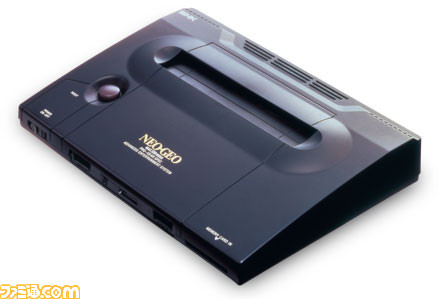
HK: Ah, we did. When I was back home on summer break from university, I’d go on late night drives with my brother, who I think was in junior high at the time. We’d stop by this video rental shop and play Fatal Fury on the Neo Geo cabinet they had off in the corner. Back then Street Fighter II was the game everyone was talking about, but I was late catching the wave and played it off like I was being cool and different by playing Fatal Fury (*24)…
*24: Fatal Fury is a 2D fighting game that was released by SNK in 1991 for the Neo Geo with an 8-way stick and punch, kick, and throw buttons. It’s known for allowing players to move back and forth between a foreground and background plane. The two player mode is a cooperative battle against the CPU, followed by a battle between players with the winner going on to continue in story mode.
YK: When you play Fatal Fury in 2P mode, it starts in co-op mode, and I think that might have been the first time I enjoyed playing a game with Hideki. (Laughs)
Toyoda: Finally, the kind of thing I’ve been waiting to hear. (Laughs)
YK: At around the same time, we were also going back and forth beating the times on F-Zero (*25) on the SNES.
*25: F-Zero is a racing game that was released by Nintendo in 1990 for the SNES featuring rotation and scaling prominently. Subtle cornering not possible with parallax scrolling became possible allowing for greater freedom when racing. The variety of techniques available made time attacks extremely popular.
HK: Huh? I bought the SNES when I was in university, so you didn’t play did you?
YK: I think you brought it with you when you were home on break. I was looking at SNES ads hard enough to burn holes in the paper, but since I was still in junior high I didn’t have that kind of money. You told me over the phone that you bought one, and that you already beat Super Mario World so you picked up F-Zero too, and that it was really fun. I remember being surprised because you hadn’t seemed interested in F-Zero at all.
HK: I don’t remember that…but when I let my friend Kuno borrow that memory-filled F-Zero cartridge, his little brother dropped it and erased all of those memories. (Laughs)
YK: Seriously?
HK: I’m pretty sure my brother had his own SNES before too long. When I was thinking about getting the SNES version of Fatal Fury, he told me that he already bought it, and I remember looking forward to going back home to play.
YK: Oh yeah. I don’t really remember how I got the SNES though…
HK: The graphics were pretty faithful to the arcade version, so when I said, “Takara really pulled it off,” my brother was like, “Wait until you see for yourself,” kind of chuckling. I thought, “What’s he talking about?” but when I got back home and tried it out…
YK: Once he got his hands on the controls… (Laughs)
HK: It was completely different! It only looked the same as the arcade, with the gameplay only vaguely resembling the original. The hitstun felt way too loose. I finally understood why my brother chuckled. (Laughs) The SNES port of Street Fighter II was incredible, so I’d just assumed they’d all be like that.
Toyoda: Well, the SNES version of Street Fighter II was faithful to the arcade version.
HK: I just remembered! This was after I’d already become an adult, but there was something else we played together. My brother and I used to go at it in Tetris Attack (*26).
*26: Tetris Attack is a competitive puzzle action game that was released by Nintendo in 1995 for the SNES. Originally titled Panel de Pon and featuring original characters when released in Japan, it was changed to feature Super Mario Bros. characters and renamed for release outside of Japan. In this game, players swap panels as they rise from the bottom of the screen to match three vertically or horizontally and erase them, dropping obstacle panels on their opponents. The player with panels filled to the top loses.
YK: That’s right, we did.
HK: When I was working on Resident Evil (*27), Tetris Attack was really popular at the office. We’d play against each other every day, to the point where work got ignored and Mikami san had to put out an order banning Tetris Attack. A while later when I went back home, my brother was there playing Tetris Attack. Now I was one of the better players at the office so I thought I’d take him on, but once we got going…
*27: Resident Evil was released by Capcom in 1996 for the Sony PlayStation. During his time at Capcom, Kamiya was involved as a designer.
YK: (Laughs)
HK: He destroyed me. I couldn’t do anything.
Toyoda: You didn’t win at all?
HK: Not once. He was on another level compared to everyone guys at work. It was like I’d hit a wall. I probably still couldn’t beat him. We played Planet Puzzle League (*28) too, but he was still really good. I think I even played you online without knowing once, didn’t I?
*28: Planet Puzzle League is a Nintendo DS game that was released by Nintendo in 2007. The Tetris Attack/Panel de Pon sequel added stylus controls which allow for faster, more intuitive play, and items that can be used during play for a variety of effects. Up to 4 players can play against each other with wireless connections.
YK: That’s right, late at night.
HK: I used to play online every night at my house in Osaka, but there was one guy I just couldn’t beat,
YK: (Laughs)
HK: When I figured I couldn’t win and gave up, I immediately got a message from my brother saying, “That was you just now, wasn’t it,” and I was like, “That was you?!” (Laughs) I couldn’t believe the day had come when I couldn’t beat my brother in a game. Young me would’ve been thunderstruck.
YK: You probably forgot, but the reason I started playing Panel de Pon was because you lent it to me.
HK: What, really?
YK: When I went to visit you at your dorm in Nishinomiya, you said, “This is fun so I’ll let you borrow it,” then gave me a mini-lecture on the active chain technique. After that I went back home with it and started training like a madman so I could beat you next time we met up.
HK: So that’s what happened…
Toyoda: By the way, did you buy every console after the NES and Master System?
HK: Yep. Although I didn’t buy a TurboGrafx-16 or Genesis at release, because my high school classmates Nagasawa and Takagi had those. Takagi had a part-time job and had the freedom to buy every console sold. That’s why everyone started hanging out at his house, and it was a given to stop by on the way home from school. Even when we skipped out on the school festival, we ended up having a game tournament at Takagi’s house.
Toyoda: (Laughs) Turbografx-16 and Genesis got add-ons.
HK: Nagasawa loves Sega so he bought the Sega CD, and Takagi bought the TurboGrafx-CD. Takagi was also an X1 user, so he had the X1, the X1 Turbo, and finally the X68000.
*29: The Sega CD is a peripheral for the Genesis that was released by Sega (currently Sega Games) in 1991. The price at release was 49,800 yen.
*30: The Turbografix-CD is a peripheral for the Turbografix-16 that was released by NEC in 1988. The price at release was 59,800 yen for the CD-ROM unit and the interface unit.
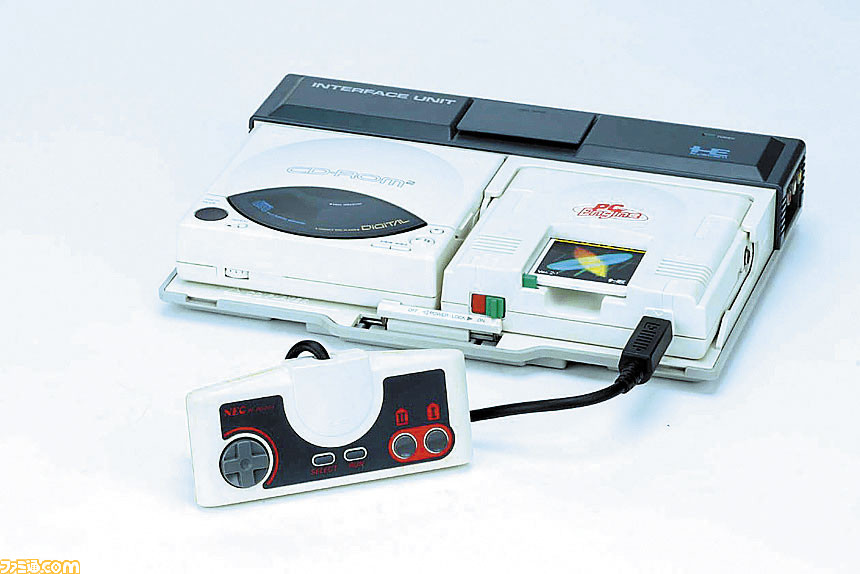
*31: The X1 Turbo was released in 1984, with graphical improvements over the original X1.
Toyoda: He was an elite gamer.
HK: Terrible at everything else, but an elite gamer. (Laughs)
YK: Takagi didn’t get involved in the console wars.
HK: That’s right. He had the money to buy every console he wanted, and was a man apart from strife.
Toyoda: (Laughs)
HK: I had a Master System, but I was a Nintendo fan so I stuck with their hardware. Nagasawa on the other hand was a Sega fan. Initially he only had a Master System. Since I was a Nintendo fan, we debated fiercely about whether the NES or Master System was better. When it came to PCs, I had the PC-88, Takagi had the X1, and Nagasawa had the MSX so we had a three-way debate about that too. However, when Takagi bought an X68000 that put a decisive end to our PC debates. (Laughs)
YK: Speaking of the Master System, there was a bit of a commotion when you bought an FM audio unit from Shimako. (Laughs)
HK: I wanted to hurry up and try it out, so I put it in the basket on the back of my back and raced home but when I got home, the basket was empty. When I panicked and went back the way I came, I saw it lying on the side of the road. (Laughs)
YK: There were a lot of unpaved and bumpy country roads so it probably got knocked out.
Toyoda: It’s been my experience that people who had Master Systems back then always talked about Fist of the North Star (*32), including myself. (Laughs) Was that the case with you?
*32: Fist of the North Star is a side scrolling action game based on the famous manga that was released by Sega (currently Sega Games) in 1986 for the Master System. The boss fight at the end of each stage is a fighting game, with scenes using Kenshiro’s special moves. Lore from the source material is used well; for example Souther can only be defeated if attacked a certain way.
HK: Whenever Nagasawa would start talking about Fist of the North Star I’d shoot back with, “That’s not about Master System or NES, that’s about Sega and Toei Animation.” (*33) (Laughs)
*33: The NES version of Fist of the North Star was sold by Toei Animation, and used a system in which Kenshiro had to defeat special red enemies and collect their final screams to power up.
Toyoda: I grew up with friends who loved games too, and we could rib each other jokingly about the hardware we didn’t have because we knew it was all in good fun, and not because we didn’t like that hardware.
HK: It was like that for me too until high school, but then there started to be a rivalry. I started to feel a lot of attachment to the machines I scrimped and saved to buy, almost as if they were things I’d created myself. That’s why I couldn’t forgive any slights against “my NES.” I think that’s how it is for people now too, at the heart of it. Something that left a big impression after I’d joined Capcom was this time a few of us who lived in the company dorms got together to hang out in the room of this guy with a Neo Geo. I got there a little late, but everyone was already hyped up over Art of Fighting 2 (*34), which he’d just bought. But back then Capcom fighting games were in full swing and were highly polished, with everything else feeling second-rate to me. As everyone was playing I was pointing out flaws in things like design and animations in a somewhat mocking manner, and guy with the Neo Geo got angry.
*34: Art of Fighting 2 is a 2D fighting game that was released by SNK in 1994 for the Neo Geo. It introduced a system in which the strength of punches and kicks corresponds to the length of time a button is pressed. It also introduced command buffers and special move cancels. There are also hidden super moves that can only be used if a character’s life bar is green and blinking that are not in the instruction manual and have to be discovered.
Toyoda: I had a Neo Geo too, so I can understand the feeling, seeing as how the console cost 58,000 yen and the cartridge cost 29,000 yen…
HK: That’s true, and when I thought about how much it cost I snapped out of it, realizing he had every right to be upset. I realized I had said some terrible things. Anyone would get mad if something they’d paid 29,800 yen for was mocked.
Toyoda: After all, the thing they thought was good enough to buy is being rejected.
HK: That goes for more than just games too. But once I got into university and away from any parental restrictions, I was free to buy the TurboGrafx-16 and Genesis. Back then I could get the consoles and games at a good price, so overnight I had every console and lost any sense of rivalry. (Laughs)
Toyoda: For your PC, you didn’t upgrade from the PC-8801 to the PC-9801?
*35: The PC-9801 was developed and sold by NEC in 1982, and was a 16-bit computer with a unique architecture.
HK: No. When I left home for university, I left my PC there and was gaming solely on console. My brother, however, bought an X68000 back home. It was the latest model at the time, the X68000 XVI. (To brother) You got it at Shimako when you were in high school, right?
YK: Right.
HK: The floor model got sold at a discount at New Year’s, right?
YK: You brought the flyer home.
HK: I did?!
Toyoda: (Laughs)
YK: I was coerced again. (Laughs) Well, I wanted it too so it was okay.
HK: How did you have the money for that?
YK: I used all of my savings.
Toyoda: That’s incredible. I didn’t know anyone hardcore enough to buy an X68000 when they were students. There was a time when I was really desperate to play Genocide (*36). (Laughs)
*36: Genocide is a side scrolling action game that was developed and released by Zoom in 1989 for the X68000. It was Zoom’s first game, but featured highly detailed graphics and mech design and cyber-rock music which were highly acclaimed. It is often seen as a title representative of X68000 exclusive title quality.
HK: The X68000 original titles were good too, but I was all about the arcade games. Takagi had the X68000 too but preferred the originals, so he only bought games like Genocide, Phalanx (*37), and Overtake (*38), so I couldn’t scratch the itch. After my brother bought his X68000 I was living in Tokyo, but I’d scour the used shops for X68000 arcade ports and send them back home.
*37: Phalanx is a side scrolling shooting game that was released by Zoom in 1991 for the X68000. It made full used of the X68000’s capabilities, featuring scaling, layered scrolling, and translucency.
*38: Overtake is an F1 racing game that was released by Zoom in 1992 for the X68000. It was approved by the Formula One Constructors’ Association and features the full 1992 F1 roster of drivers.
YK: Even though I live away from our parents’ home now, I still keep the X68000 and games stored there.
HK: You’re still taking good care of them. Boot it up sometimes! There was that problem a few years back…
Toyoda: Did you have it repaired?
YK: There was a battery fluid leak that was fairly common. Someone was offering to fix it at auction, so I had Hideki bid.
HK: My brother doesn’t have a Yahoo Auction ID, so I bid on it and contacted him. It happened to be someone else from Nagano.
Toyoda: Sounds like fate.
HK: He was about an hour away from Matsumoto by car, so you loaded up the X68000 and went, right?
YK: With Mom and Dad too. (Laughs)
HK: Why did you take them? (Laughs)
YK: To get in some sightseeing too.
Toyoda: You really are taking good care of it.
YK: The keyboard broke a while ago, so I had Hideki bid on another one.
HK: I had him give me the model number, then I watched for one to pop on auction, bid on it, and sent it to our parents’ house. By the way, his game collection is amazing. He’s got more console games than me now. (To brother) You store the boxes really carefully too.
YK: I’m collecting Xbox and Xbox 360, and PlayStation 1-3 now. I keep the disks on hand and have the boxes on shelves at our parents’ house.
HK: Our parents’ house was rebuilt while I was in university. I went to Osaka later so I never lived in the new house, but my brother had his own room there before moving to Tokyo. The shelves in that room are jam packed with game boxes. (To brother) You had the 64DD too, right?
*39: The 64DD is a peripheral for the Nintendo 64 that was co-developed by Nintendo and Alps Electric, and released in 1999.
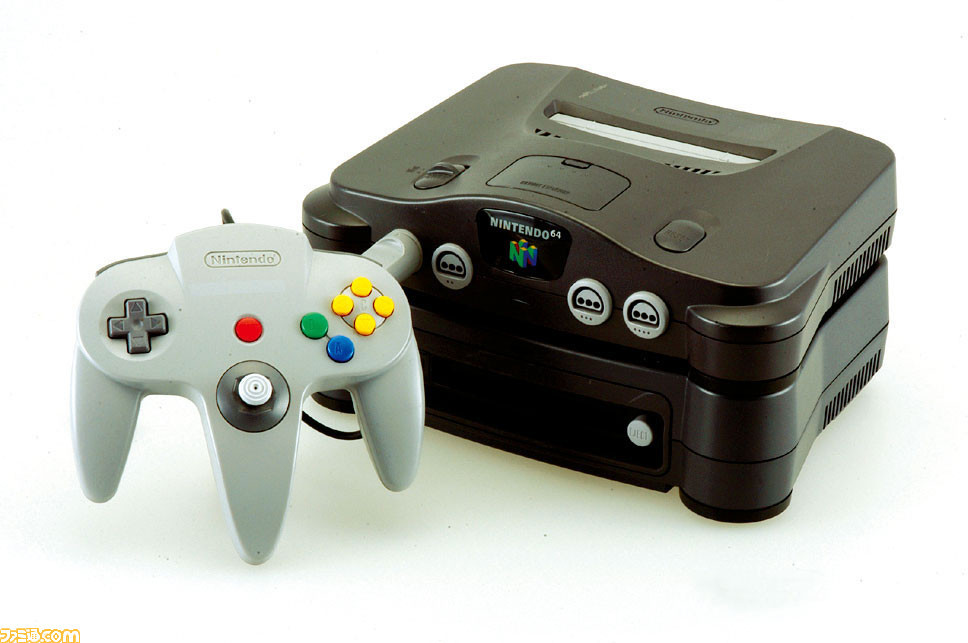
YK: That takes me back. (Laughs)
HK: These days I pick up niche hardware like the Pippin ATMARK as a collector, but my brother was using the 64DD when it was new. You’ve got some games too, right?
*40: The Pippin ATMARK is a Macintosh compatible multimedia device that was co-developed by Bandai Digital Entertainment and Apple, and was released in 1996. It came loaded with a dial-up modem for connecting to the Internet.
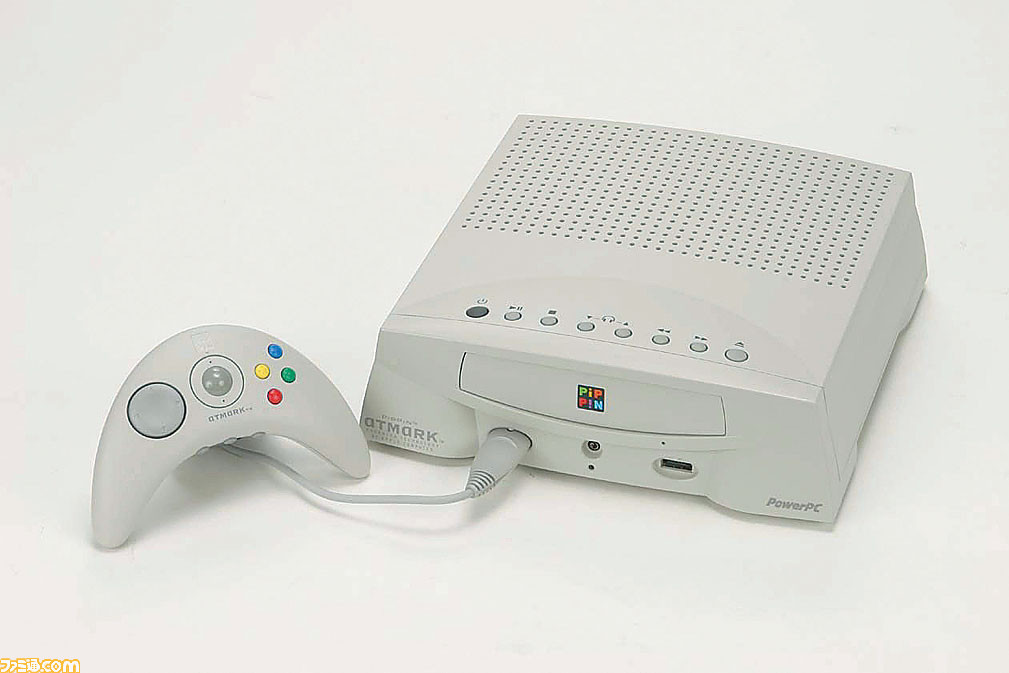
YK: I’ve got Doshin the Giant (*41), the F-Zero X Expansion Kit (*42), and a few others.
*41: Doshin the Giant is a 64DD game released by Nintendo in 1999. Doshin the Giant 1 was distributed to Randnet service members, and an expansion titled Kyojin no Doshin: Kaiho Sensen Chibikko Chikko Daishugo was later released in 2000.
*42: The F-Zero Expansion Kit was distributed to Randnet service members, allowing players to add cups and create their own courses and machines.
HK: Didn’t you also make a lot of stuff?
YK: Yes, with the Mario Artist series. With Talent Studio, I imported pictures of faces taken with the Game Boy Camera and pasted them on polygon models, then made short films. There were some using your face too. (Laughs) In Polygon Studio I played mini games that formed the base of what Wario Ware became, and downloaded models from the internet using Communication Kit.
*43: The Mario Artist series of games was a set of creative tools for the 64DD designed for the creation of images, movies, 3D models, and games using that created 2D and 3D art. It consisted of Paint Studio, Talent Studio, Polygon Studio¸ and Communication Kit. :
*44: Wario Ware is a mini game collection that was released by Nintendo in 2003 for the Game Boy Advance. It includes the 8 mini games found in Mario Artist: Polygon Studio.
HK: My brother is pretty diligent, and makes a lot with creative games. He remade Xevious in Dezaemon (*45) on NES, and in Shooting 68K (*46) on the X68000, he made some Mega Man (*47) and The Legend of Zelda-themed vertical shooters.
*45: Dezaemon is a shooting game creation tool released by Athena in 1991 for the NES. Players are able to create original graphics and music as well.
*46: Shooting 68K is a shooting game creation tool that was developed by Amorphous and sold in Brother Industries’ “TAKERU” PC game vending machines in 1991.
*47: Mega Man is an action game that was released by Capcom in 1987 for the NES. Players control the hero Mega Man and defeat robot masters, strategizing which areas to visit and weapons to use as they play.
YK: I did! I replicated a full stage from Gradius as a vertical shooter. I also replicated Terra Cresta in Kaite Tsukutte Asoberu Dezaemon (*48) on SNES.
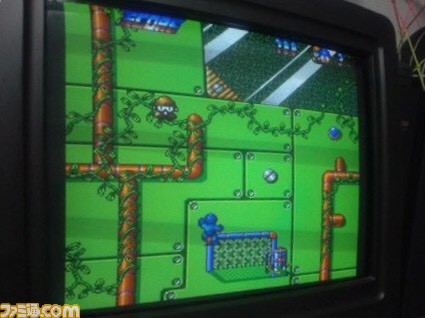
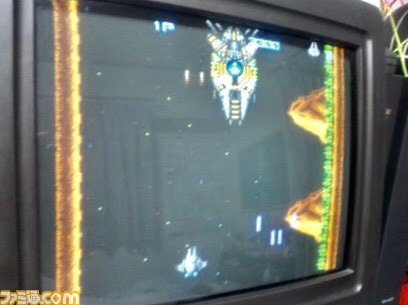
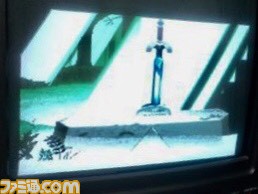
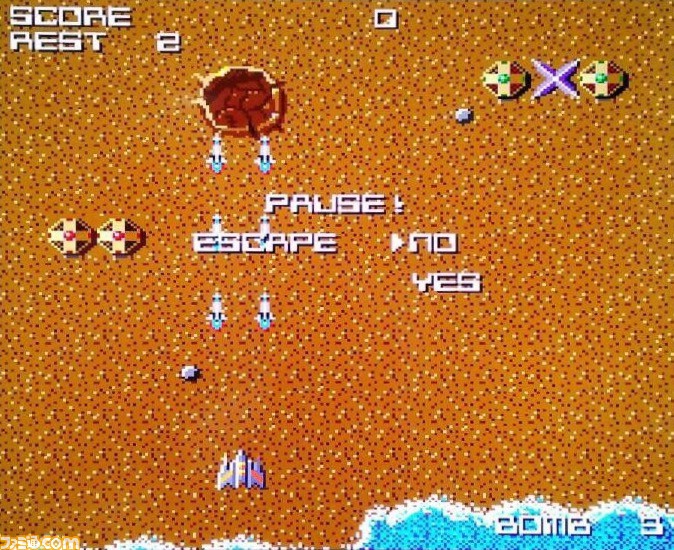 Photos of the younger Kamiya brother’s creations. The degree of quality is quite frankly astounding.
Photos of the younger Kamiya brother’s creations. The degree of quality is quite frankly astounding.
Toyoda: That’s outstanding! Incidentally, what motivated you to start collecting?
YK: It was less that I started collecting, and more that my collection just grew as I kept buying. I’d say it’s still a relatively small amount–although it does cover a wall.
HK: You have a lot, much more than the average person would buy.
YK: Some of those are yours.
HK: No, hardly any of them are because I stopped buying as many games around the time the PlayStation came out.
YK: Really. Then I guess all the recent games are mine.
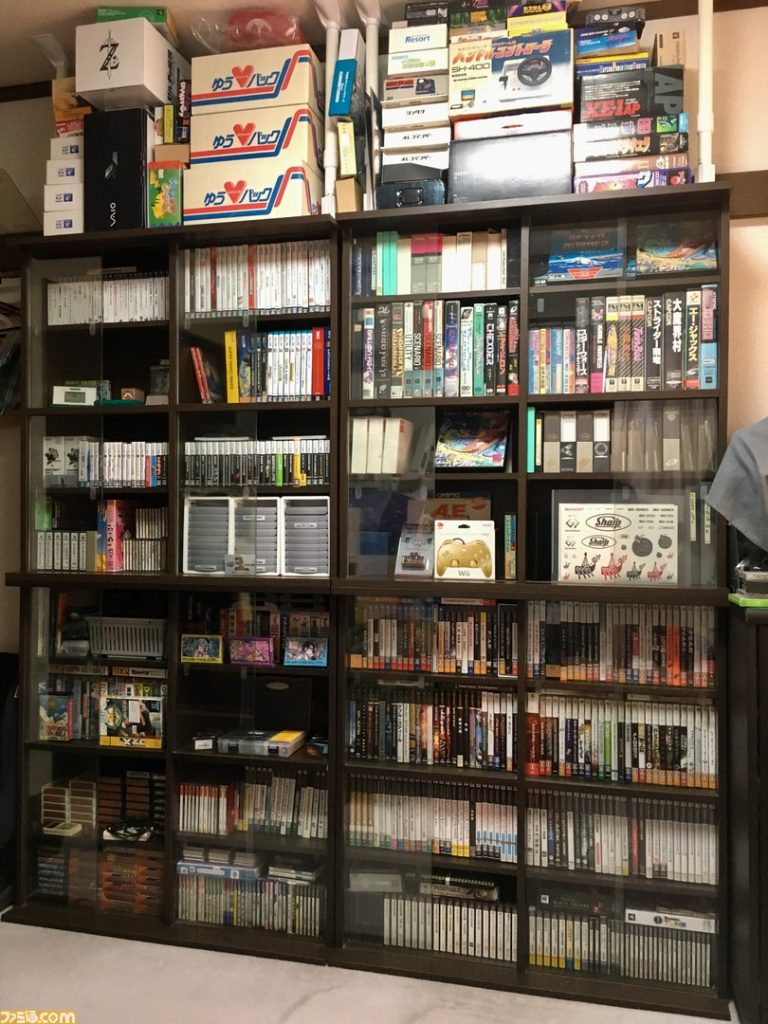
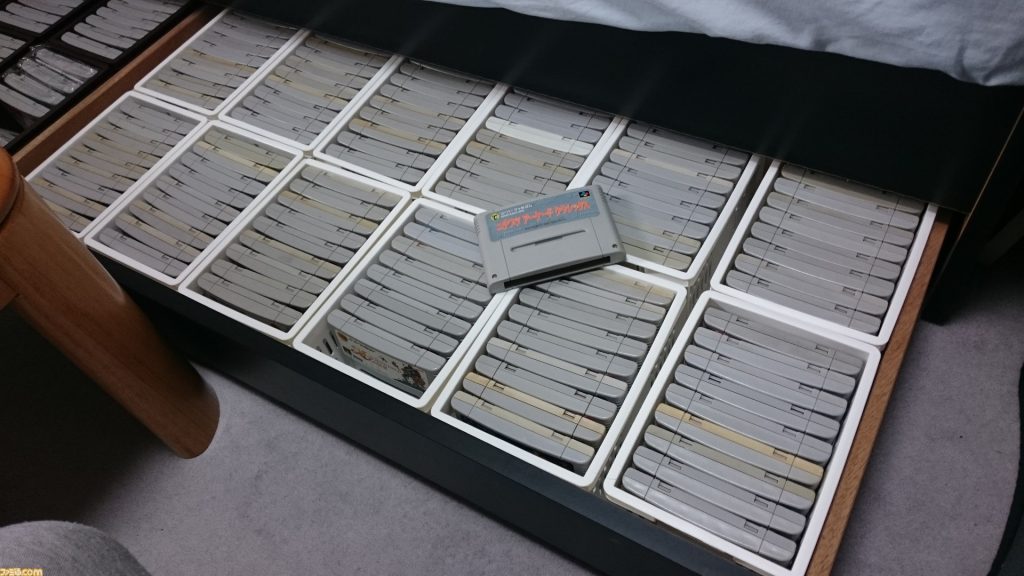 Photos of the younger Kamiya brother’s game shelves. As you can see, there are indeed more games than the average person buys.
Photos of the younger Kamiya brother’s game shelves. As you can see, there are indeed more games than the average person buys.
HK: Some of my Disk System and Master System games are mixed in…
Neither my brother nor I sell games; even if we stop playing them we hold on to them, which is why the collection keeps growing. Oh, and he plays a lot of western games.
Toyoda: Is that so.
HK: But he doesn’t play the games that I made.
YK: I played some. Okami (*49) for example.
*49: Okami is an action game that was designed and developed by Clover Studio Co., Ltd. and released by Capcom in 2006 for the PlayStation 2. Kamiya was the director.
HK: But you didn’t play Devil May Cry or Viewtiful Joe.
His taste in games is lopsided.
*50: Devil May Cry was released by Capcom in 2001 for the PlayStation 2. Kamiya was the director.
*51: Viewtiful Joe was released by Capcom in 2003 for the Nintendo Gamecube. Kamiya was the director.
YK: I like FPS, and there are a lot of titles that weren’t sold in Japan, so I go to stores that sell games from other regions.
HK: Sometimes when I go back home for New Year’s and we’re together at our parents’ house, he’ll just be shut up in his room wearing headphones and playing shooters.
Toyoda: He’s also into Xbox…
YK: I liked FPS games, so naturally I bought an Xbox.
HK: You played PC games a lot too, right? Stuff like Crysis (*52).
*52: Crysis was developed by Crytek and released by Electronic Arts in 2007 for the PlayStation 3, Xbox 360, and PC.
YK: Yeah, I played PC a lot.
HK: You even built your own PC for that.
Toyoda: I’m surprised you never got the PC-9801.
HK: I played PC-88 games a lot. Back then Snatcher (*53) was especially impressive. While it probably takes a lot from Blade Runner, you get a depiction of an amazingly dense and detailed world wherever you look and with each line. There was a sense of scale throughout the game, and it’s why I got so into PC games after buying the PC-88. Like I said before, the NES was in Dad’s bedroom so I couldn’t play whenever I wanted to, but the PC was in my room so I waited for my parents to fall asleep, then played every night.
*53: Snatcher is an adventure game that was released by Konami (currently Konami Digital Entertainment) in 1988 for the PC-8801 and MSX2 computers. It was later ported to the Super CD-ROM2 as Snatcher CD-ROMantic.
YK: You waited on edge for the lights in the living room to go off.
HK: The door to the living room was right behind the sliding doors of my bedroom. When the light in the little window in the door went off, that was the sign that my parents went to bed so I turned on the PC. (Laughs)
YK: By the way, that window got broken when Dad and Hideki got into an argument, and got papered over.
HK: I couldn’t tell when the light went out after that and wished I hadn’t done that. (Laughs)
Toyoda: (Laughs) At any rate, you played on the PC-8801 when it was in its prime.
HK: The grand fantasy world of Sorcerian left a big impression on me and I got totally immersed. There were story expansions sold too, so I played for a very long time. There were also masterpieces like Silpheed (*54) and Star Cruiser (*55). True 3D visuals made with polygons and wire frame made a big impact, and I’d turn the lights off in my room to watch the opening movie for Silpheed over and over again. In Star Cruiser you move by warping from planet to planet, but the game is designed so you can fly without warping too, and you can fly through increasingly vast space as you take out enemies. There was also a great port of Space Harrier with FM sound on par with the arcade version and large characters that moved fluidly. It was a world you couldn’t experience on your average home console. On the other hand, the NES could do both scrolling and sprites, making it perfect for fast-moving action games so you get games like Super Mario Bros. which aren’t really designed for the PC-88. The different machines have different characteristics and as a result allow for enjoying different kinds of games. However, the PC-88 was in my room, so I never let my brother play.
You don’t have any PC-88 memories, do you?
*54: Silpheed is a shooting game that was released by Game Arts in 1986 for the PC-8801mkII and compatible machines. Appearing in the early days of polygon games, it displayed 15 polygons a second in order to create expansive play areas in what was otherwise a 2D vertical shooter.
*55: Star Cruiser is a polygonal shooting game that was released by Arsys Software in 1988 for the PC-8801mkII SR and compatible machines. A space opera taking place after humanity has set off into space to explore, it is acclaimed as a work of science fiction that deals with physical cosmology and predictive physics. Players don’t move within a limited area, but are instead free to fly through the vastness of space.
YK: I have a few, like Hydelide 3. I remember using a trick to make a strong character.
HK: I remember making you a user disc. Any other games?
YK: I’m played a few here and there. I remember playing Veigues (*56).
*56: Veigues is a side scrolling action game released by Game Arts in 1988 for the PC-8801mkIISR and compatible machines. Players pilot a robot as they make their way through stages.
HK: Really, you played Veigues?
YK: I also clearly remember hitting the switch while I was playing something…
HK: Hey, now I remember!
YK: I was still a little kid. (Laughs)
Toyoda: Ah, now I see. You’re talking about the power switch.
HK: I let you play Veigues in 6th grade…
YK: And as a result…
HK: Veigues stopped working!
Sorry, didn’t mean to leave you out. (Laughs) He found out the screen on the PC-88 would bug out if you turn the power on and off, and of course as a kid he loved that so he flipped it over and over. (Laughs)
YK: I couldn’t imagine doing that now. (Laughs)
HK: With the NES we’d have fun making it bug out on purpose by putting the cartridge in at an angle or something like that, but he was doing it with an expensive PC. I came home from school and he shows me like, “Look at this!” and I said, “What are you doing, dummy!” In the manual it said something like, “Please wait ten seconds after cutting the power before turning it back on again.”
Toyoda: I always waited 30 seconds.
HK: After that, when I played Veigues it bugged out. I didn’t know much about PCs them, but there was a command to run a self-diagnostic check on the RAM so I did, and it was of course destroyed, and I had to send it off to be repaired.
YK: It wouldn’t even play the entirety of that legendary opening movie—it would just freeze around the part where the shutter opens and show a strange line of text. (Laughs)
Toyoda: (Laughs)
HK: I’m not sure why, but the disc was damaged too. When I took it to Shimako for repairs, it froze in the same place when they booted it up on the store machine. I got it exchanged, but the disc got damaged again on our supposedly repaired PC-88. So I never got to see the whole opening movie for Veigues.
YK: But now you can watch the whole thing on YouTube. (Laughs)
HK: I recently bought a PC-98DO+ (*57)…
*57: The PC-98DO+ was a hybrid machine that could run software from both the PC-98 and PC-88 series. The CPU was a V33, and in 88 mode the sound functionality was on par with the PC-8801MA2.
Toyoda: That’s a popular model at the used stores.
HK: So I was finally able to watch the opening movie at home. (Laughs)
Toyoda: Looking back, you lived through a really good era.
HK: That’s definitely true.
Toyoda: As children when home gaming first came on the scene, you’ve been able to experience them all as they came along.
HK: We definitely had a taste of the best. We saw video games in Japan change in real time.
There were games that I got to play thanks to you, and games you got to play because of me.
YK: Yeah, like Takeshi’s Challenge (*58).
*58: Takeshi’s Challenge was released by Taito in 1986 for the NES. Directed by Beat Takeshi, the game is extremely difficult and was released at a time before the Internet was widely available, meaning that nearly no one was able to beat it.
HK: That doesn’t need to be played. (Laughs)
Surprisingly this happened while I was going to cram school, but I had an argument with my parents because I wanted them to let me buy a game for my birthday. I ended up nearly forcing the money out of them and went to Shimako, but there was nothing I really wanted…so after puzzling it over for a while I ended up buying Takeshi’s Challenge, which was a… unique game. (Laughs) But after arguing like that with my parents, I had to at least play it. After playing for a while my dad asked if it was fun. The most I could say was, “If you hit a townsperson you get 300 yen.” (Laughs)
YK: You were a delinquent in cram school…
HK: I didn’t play for a long time after that, but as an adult I found out how to beat it and saw the ending, and was fairly impressed.
You’ve got better games to be grateful for, right? Super Mario Bros. 2 (*59) for the American NES (*60) for example.
*59: Super Mario Bros. 2 was released in America in 1988 by Nintendo. It is different from the Japanese version of Super Mario Bros. 2, known outside of Japan as Super Mario Bros.: The Lost Levels.
*60: The American version of the NES uses 70-pin cartridges and is not compatible with the Japanese NES, better known as the Famicom.
YK: The one you bought in Akihabara, right?
HK: Right.
When I was in high school, I went to Tokyo with my dad once. I told him I wanted to go to a store that sold imported games, so we went to Akihabara.
Toyoda: I’m surprised you knew about it back then.
HK: I was probably relying on ads I saw in MyconBasic. It was a store called Messe Sanoh (*61).
*61: Messe Sanoh was a long-standing game store in Akihabara, but it unfortunately closed after merging with Trader in 2012.
Toyoda: Ah, I see. Messe Sanoh was very well known.
HK: There weren’t any stores selling imported games in Nagano, so I really wanted to go. The store was really cramped and very sketchy. (Laughs) But I was really excited by that underground feel. There was a lot I’d never seen in Matsumoto, like an Atari Lynx (*62). You could play Blue Lightning (*63) and I thought, “The Atari Lynx is amazing….Tokyo’s amazing…” (Laughs)
*62: The Atari Lynx is a handheld game device that was released by Atari Corporation in 1989. It was the first handheld with backlighting and a color LCD screen, and to feature sprite scaling and rotation. In 1991, a streamlined version called the Atari Lynx II was released.
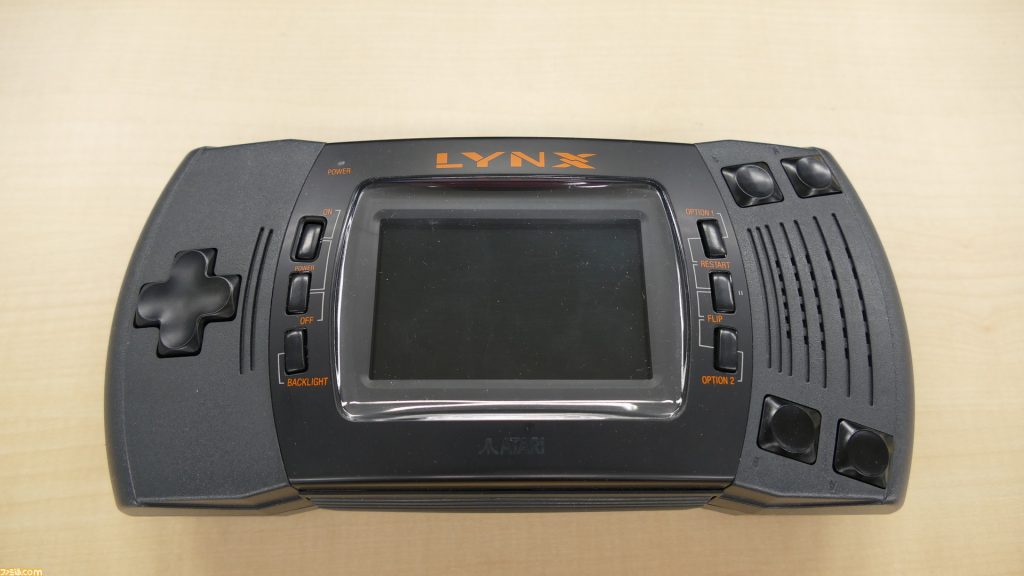 The Atari Lynx II
The Atari Lynx II*63: Blue Lightning is a shooting game that was released in 1989 for the Atari Lynx. Players pilot a fighter jet and can enjoy dogfights, but the focus is on low altitude combat and destroying enemy tanks and bases with your Vulcan guns. When certain enemy planes are shot down, a special ejection scene is shown.
YK: For someone from Nagano, Tokyo was like a different world.
HK: Sometimes I’d go to Tokyo when visiting my cousin Shin in Chiba, and there were things you didn’t see in Nagano like giant neon signs and elevated highways. It was like the future. So I bought Super Mario Bros. 2 and an adapter at the store. I’m sure I saw an ad for it and wanted to go buy it. The game itself is the same as Doki Doki Panic but I was happy to have something you couldn’t get in Japan.
*64: Dream Factory: Doki Doki Panic is a side scrolling action game that was developed by Nintendo and sold by Fuji Television in 1987 for the Disk System. Based on the “Communication Carnival Dream Factory ‘87” event held by the Fujisankei Communications Group in 1987, the game’s stars are the “Imagine Family,” who are characters from the event. The American version of Super Mario Bros. 2 is an adaptation of this game that replaces the Imagine Family with Mario, Luigi, Peach, and Toad.
YK: Now I remember. I bragged about it to my friends.
HK: Of course I bragged about it to Takagi and Nagasawa, but my brother called his friends over to brag about it too. Back then he was still in elementary school, so he must have been pretty puffed up. (Laughs)
Toyoda: Back then, did you play every game you bought until you beat them?
HK: Even if I couldn’t beat something, I’d play over and over again. I didn’t get a lot of games, so when I did get one I felt like I had to squeeze as much fun as possible out of it.
Come to think of it, I had you get Shinobi (*65) for the Master System.
*65: Shinobi is a side scrolling action game that was released by Sega (currently Sega Games) in 1987 in arcades, and then in 1988 for the Master System.
YK: Was that me?
HK: Yep.
Shinobi had some issues too, but since we got it I made an effort to get through and see the ending. Then all I got was a screen with “GAME OVER.” I was extremely regretful that I’d made that much effort to beat that game. (Laughs)
YK: I’m surprised you could say that after making me buy it… (Laughs)
HK: I used to think the Master System version of Shinobi was boring because I was a port, but recently I realized that the arcade version wasn’t that great either. (Laughs)
Toyoda: You seem to have a love-hate relationship with Sega, like you mentioned during your talk with Yosuke Okunari.
*66: Kamiya spoke with Yosuke Okunari, the architect of the Sega 3D Classics project, in a previous interview.
HK: That’s right. Sega made wonderful arcade games, but their home versions had problems so my feelings about them are complex. (Laughs) Space Harrier is great. I bought it after seeing the commercials and got just what was promised. Now I realize the music used in the commercials was from the arcade version, but the Master System audio was also very good. The one I can’t forgive is Outrun. I bought it without first seeing console footage, and the landscape changes done with parallax scrolling in the arcade version were done by changing sprites on the Master System. It was a mess! On the other hand, Rad Racer (*67) on the NES came out around the same time and had smooth parallax scrolling.
*67: Rad Racer is a racing game that was developed by Square (currently Square Enix) and released in 1987 for the NES. It uses sprites and parallax scrolling for smooth depictions of rolling landscapes, and was the first game to be compatible with Famicom 3D.
Toyoda: I was really into Sega arcade games too, so I know where you’re coming from.
HK: To make things worse, Beep didn’t review it properly at the time. They said that the rolling landscape was done just right, and I believed them and bought it but it was so clunky I wondered if my Master System was broken.
Toyoda: (Laughs)
HK: Another wound came from Final Bubble Bobble. The graphics were better than the NES version, but when I bought it I realized there was no FM sound. The Beep review didn’t mention that either. Then in the next issue, there was a small apology for the omission. I hooked up an FM unit without knowing that so I was thinking, “Write that in the first place!”
*68: Final Bubble Bobble was developed by Taito and released by Sega (currently Sega Games) for the Master System. It has 200 stages and a password continue feature.
YK: Don’t get so worked up. (Laughs)
HK: The last straw was After Burner (*69). Beep was heaping praise on it, saying, “The only thing missing is a moving cabinet!” and Nagasawa the Sega fan bought it immediately, regaling me with how great it was. So I told him to bring it over to show me…
Did you see it then too?
*69: After Burner is a 3D aerial dogfighting game that was released by Sega (currently Sega Games) in arcaded in 1987, then later that year on the Master System. It was actually a prototype and 3 months after release, an adjusted version called After Burner II, which added a throttle lever, was released. Only one double cradle cabinet version of After Burner II cabinet exists, but it’s for display only and can’t be played. Incidentally, the Master System version is the only home console port of After Burner.
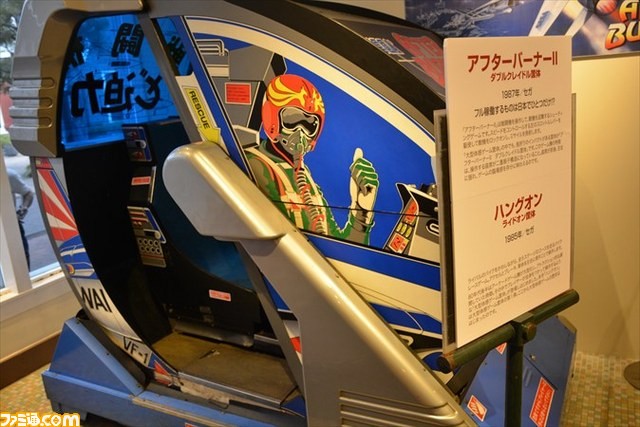
YK: Nope.
HK: You didn’t see it back then?
YK: That’s right.
HK: No joke, I had no idea what I was looking at when I saw that After Burner…
All: (Laugh)
HK: Right?
YK: It’s pretty bad. (Laughs)
HK: Nagasawa played that janky mess like nothing was wrong, I was thinking, “What are you seeing right now?” (Laughs)
Toyoda: (Laughs)
HK: Hold on, Let me show you OutRun on the console.
(Shows OutRun on the Master System)
HK: Look, right here. Unbelievable, right? Those are stairs, not a slope! You can see how shaky this is.
YK: The slope is bad.
HK: Look at this! How the slope moves! Ok, now this is After Burner.
(Shows After Burner on the Master System)
HK: This is After Burner…
YK: That pitiful BGM. (Laughs)
HK: You can’t tell what this is supposed to be, and I’m sure they could have come up with some better sprites.
YK: I remember joking that the pilot’s face in the movie looked like a Moai statue. (Laughs)
Toyoda: (Laughs) The more you like the arcade version, the easier it is to see the differences in the port.
Incidentally, was there a specific reason you had for wanting to get into the game industry?
HK: The clearest memory I have regarding that was reading the industry rumors section in Famitsu back in college. There was a rumor that Capcom was making a Genesis version of Street Fighter II and I really wanted to know if that was true. I remember thinking that if I got into the industry, I’d know all the rumors… but now I realize there are still some things you can’t know. (Laughs) I did find out that Capcom was actually making a SNES version of Super Street Fighter II (*70).
*70: Super Street Fighter II was released by Capcom in 1993 in arcades, and then in 1994 for the SNES and Genesis. It added four new characters: Cammy, T. Hawk, Fei Long, and Dee Jay.
YK: (Laughs) Back then we waited with baited breath for game magazines to come out, although we actually preferred Family Computer Magazine. (Laughs) We looked forward to it every month.
HK: I read every issue since the first one, sent Stinger high scores to the High Score Room, sent postcards to their trick column…I was hungry for any game information I could get, and was jealous of those who were around it. Back then, I figured that I’d be able to see a different world if I got into the industry. But even in junior high school I admired game creators and in essays I’d write stuff like “I’m definitely getting into Namco.” At first I just had a vague image of what a game creator was, but I read a “Game Designer Dialogue” with Shigeru Miyamoto and Masanobu in Family Computer Magazine, learned that there was a game designer job, and took a stronger interest.
*71: Stinger was released by Konami (currently Konami Digital Entertainment) in 1986 for the NES. It’s the only game in the series with 3-player co-op play, with the 3rd player ship “GwinBee” making its first appearance. It keeps the bell power up system from earlier games while mixing up horizontal and vertical stages.
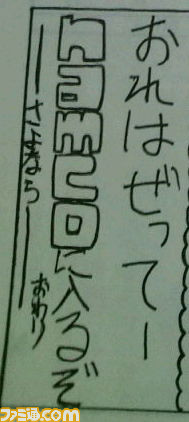 An excerpt from Kamiya’s graduation essay. “I’m definitely getting into Namco. Later!”
An excerpt from Kamiya’s graduation essay. “I’m definitely getting into Namco. Later!”YK: In the end you got into the industry, so your lifetime of gaming didn’t go to waste.
HK: True…
My brother has a more traditional job, which I’m sure gave our parents some relief. (Laughs) I just played games because I like them, and I’m really grateful to my parents. They were sometimes strict, but still let me get away with buying consoles here and there and were honestly very understanding.
Toyoda: What led to you collecting classic games?
HK: What indeed?
YK: It was probably a reaction.
HK: To what?
YK: Not being able to buy that many games before.
HK: That’s probably some of it, but…I can’t really think of a clear reason.
Toyoda: No desire to have the next generation play and learn something?
HK: I do feel that to some degree, but my collection is for myself. There’s probably a part of me that just wants to bask in the good memories. That kept getting bigger and eventually I started collecting games that I didn’t play in the past as well. There are waves in the industry, just like I had. There was a time when we didn’t want to just pass something down or leave it like it was, but add something new and original when porting. I’m not sure if this is a good example, but something like R-Type Complete CD (*72) for the Super CD-ROM2 (*73). The original port split R-Type and R-Type II due to the space limits of the HuCard, but it’s a really good port. Then they took advantage of the space on CD-ROM to put them together, but the BGM was changed to weird live arrangements. Just listening gives me goosebumps…
*72: R-Type Complete CD was released by irem in 1991 for the Super CD-ROM2, and combines R-Type and R-Type II. It also takes advantage of the systems abilities to add improved visuals and new music arrangements.
*73: The Super CD-ROM 2 is a peripheral for the Turbografix-16 that quadrupled the SRAM of the Turbografix-CD, and was released by NEC in 1991 for 47,800 yen. The Turbografix-CD could also be upgraded to the Super CD-ROM2 by inserting a “Super System Card” into the Turbografix-16.
YK: It sounds like grocery store music…
HK: But the industry has come through those kind of periods where people think doing something like that adds value, and by going through those we’ve come to a point where people see the value in a perfect replication. Virtual Console is an example of that, and Arcade Archives is especially wonderful. Being able to play arcade games at home is an unchanged dream. In some part it’s a high priority to cater to adults who have that dream. Even for me, there was a time when I would see something like Super Mario All-Stars (*74), basically a dressed up Super Mario, and think, “Hey, that’s nice!” but gradually I’ve come to want to experience the same thing I did back in the past. Getting to that point, I now have this desire to play the old stuff, but with it looking much nicer. I have RGB (*75) output-modded versions of all the classic hardware, including TurboGrafx-16, Genesis, and Master System. With that, the sprites are crystal clear, and I’ve really come to appreciate that.
*74: Super Mario All-Stars was released by Nintendo in 1993 for the SNES. It includes Super Mario Bros., Super Mario Bros.: The Lost Levels, Super Mario Bros. 2, and Super Mario Bros. 3, all with 16-bit graphics and sound.
*75: RGB output makes the outlines of text and sprites stand out more clearly, creating a crisper overall image.
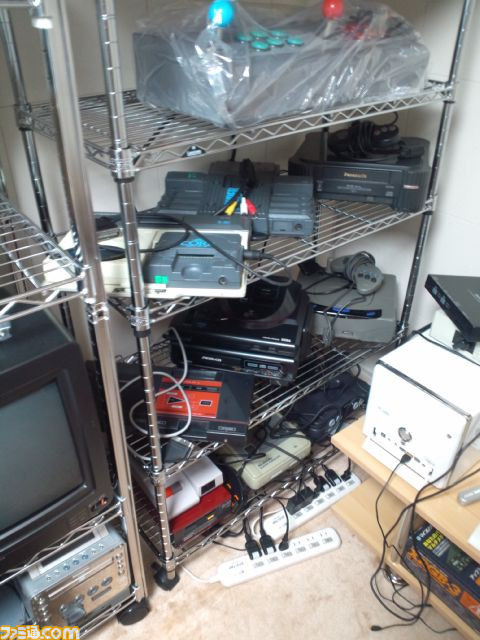
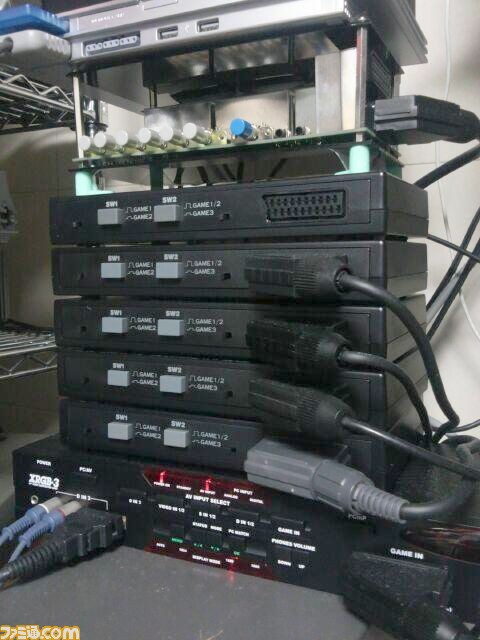 “This is my current console setup at home. They’re all RGB output and in working order.” (Photos and comments courtesy of Hideki Kamiya)
“This is my current console setup at home. They’re all RGB output and in working order.” (Photos and comments courtesy of Hideki Kamiya)
Toyoda: Do you have a CRT television too?
HK: I do. I use PC monitors at home, but I brought a CRT to the office and have all the classic consoles hooked up to it, since I have a few extra of each. (Laughs) They can all be played with RGB and not the old RF, making the picture really crisp and a joy to play.
YK: It’s like that at your home arcade too.
HK: Since arcade games are a big part of my formative experiences with gaming, I feel pretty strongly about them. Many of them never see a console port, or get one that’s not very faithful, so eventually it got to the point where I decided to get the real thing. Now I collect arcade system boards, focusing on the 80s. Gradius and Space Harrier were like my gaming Old Testament and are especially important to me and I wanted to have them in their original state, so I got the original cabinets to relieve those memories faithfully.
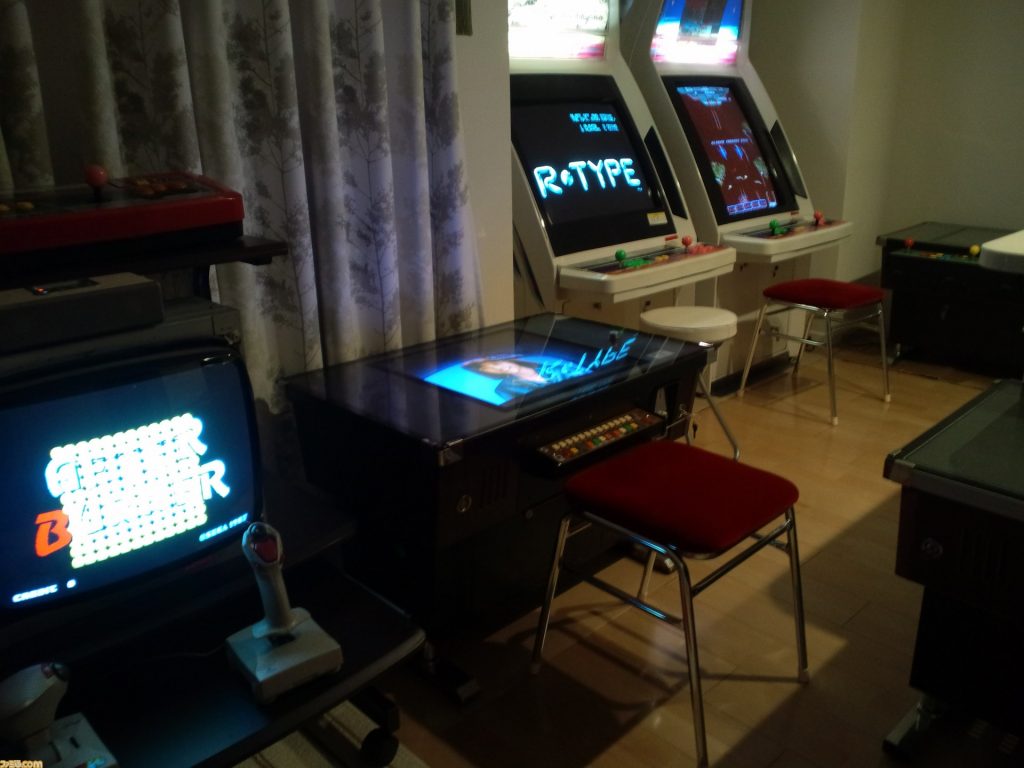
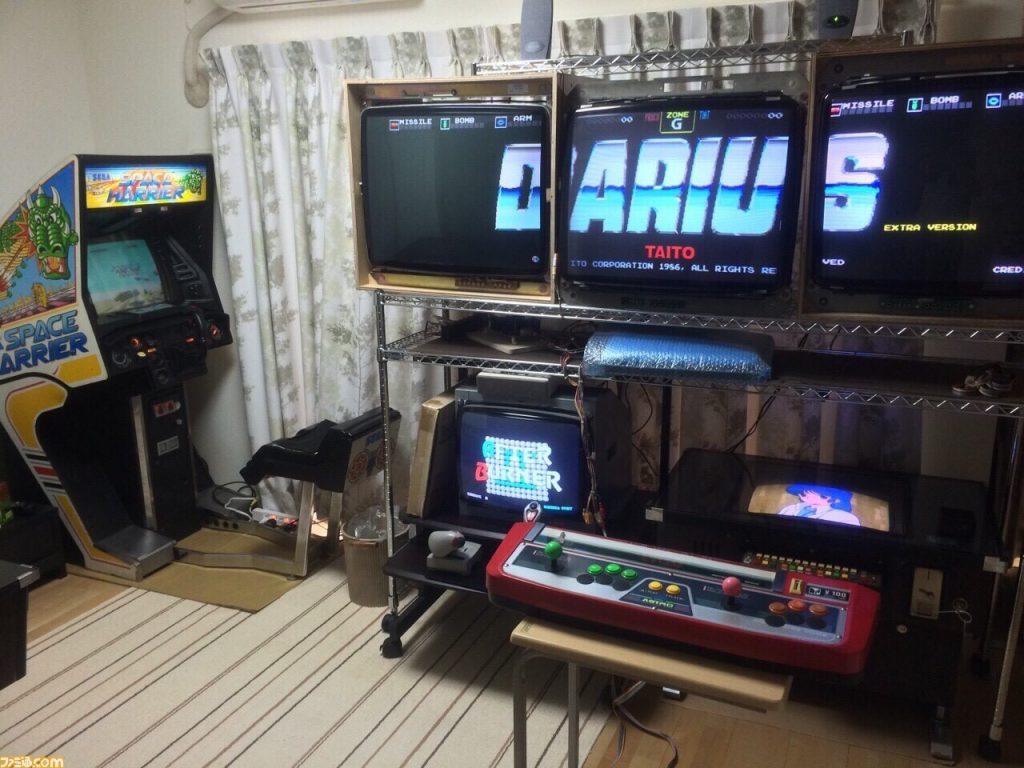
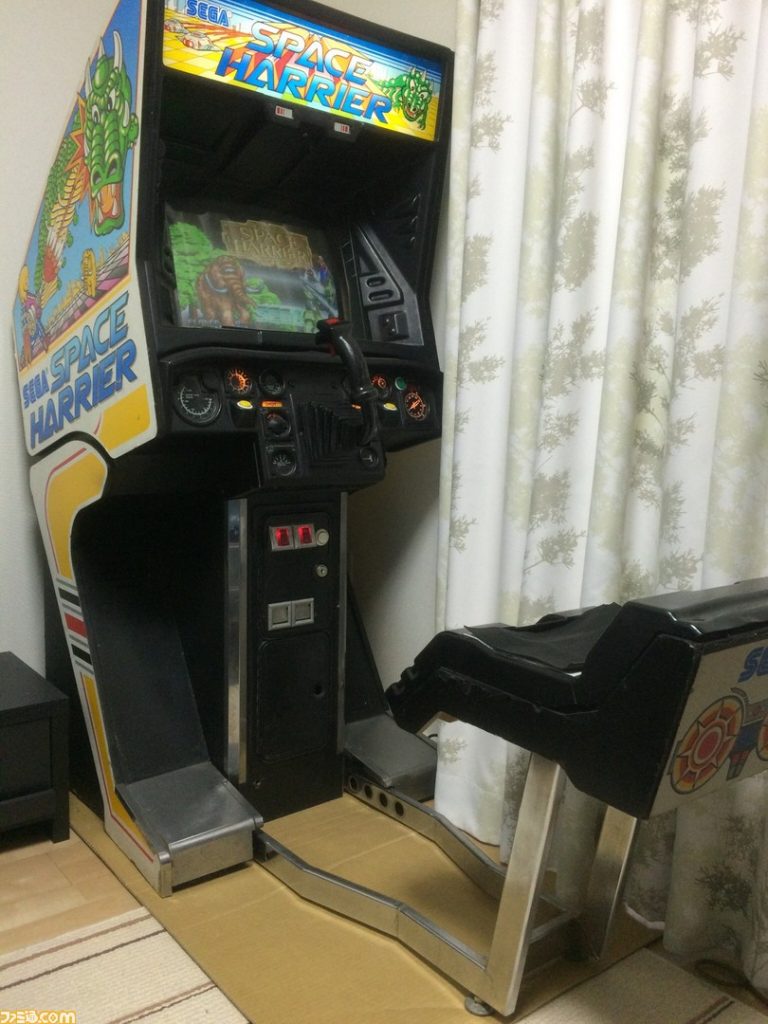
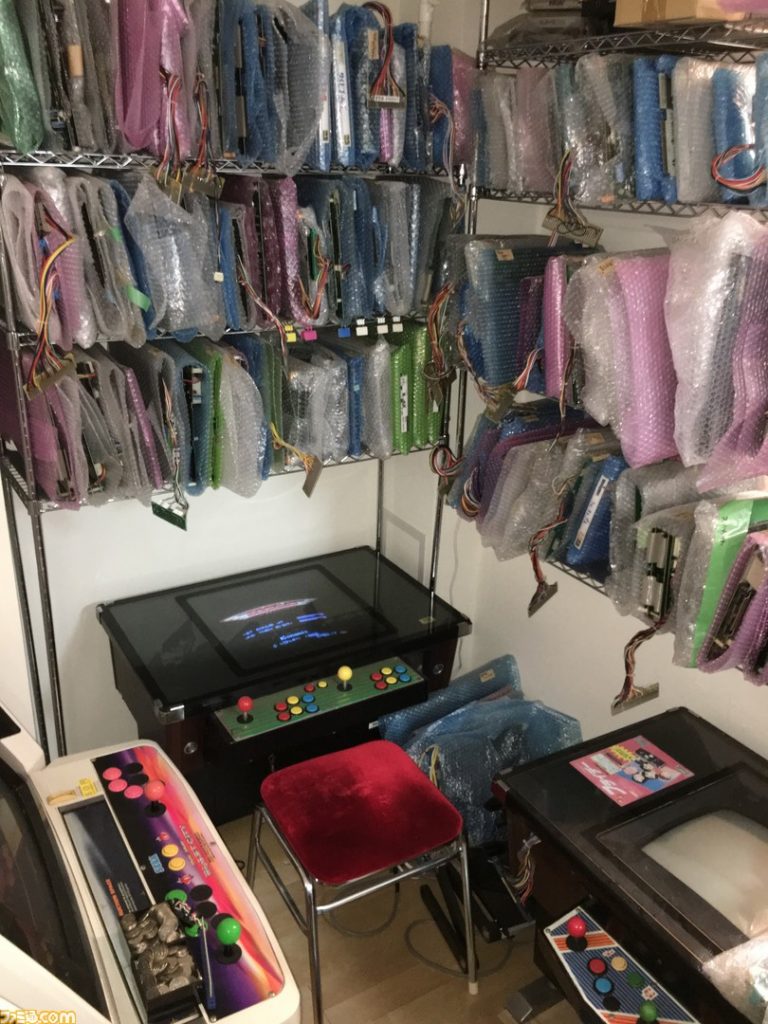
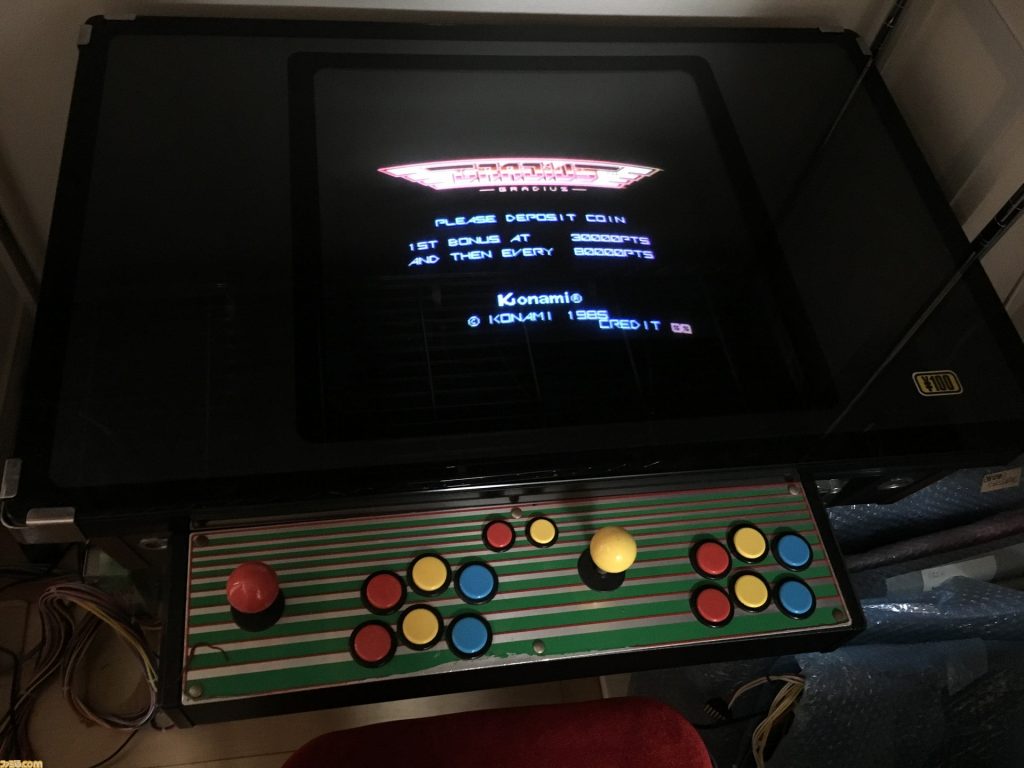 “This is my current home arcade setup, focused mainly on games from the 80s. I haven’t counted how many boards I have, but I think I have at least 100.” (Photos and comments courtesy of Hideki Kamiya)
“This is my current home arcade setup, focused mainly on games from the 80s. I haven’t counted how many boards I have, but I think I have at least 100.” (Photos and comments courtesy of Hideki Kamiya)
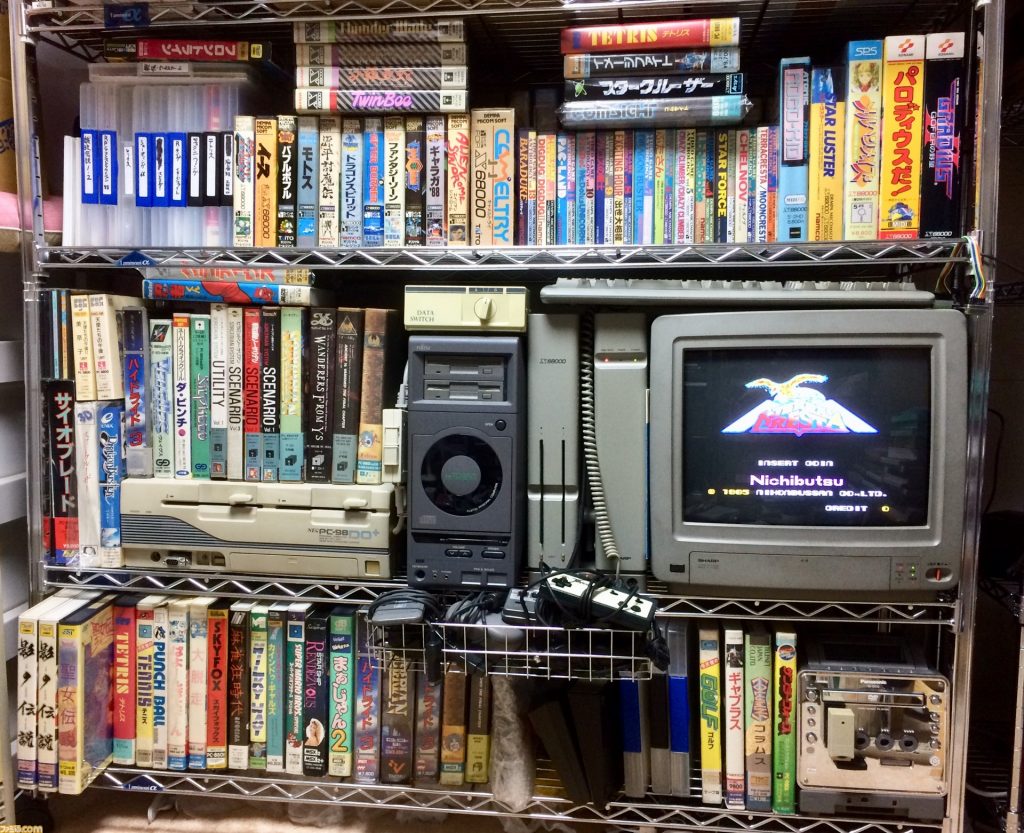
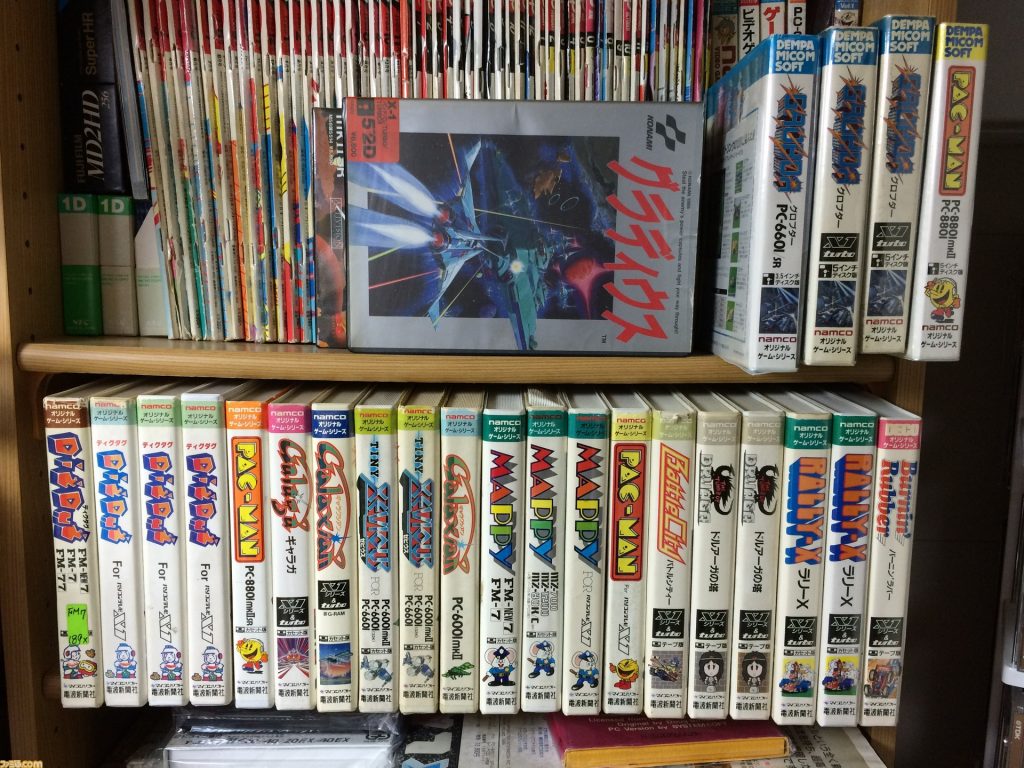
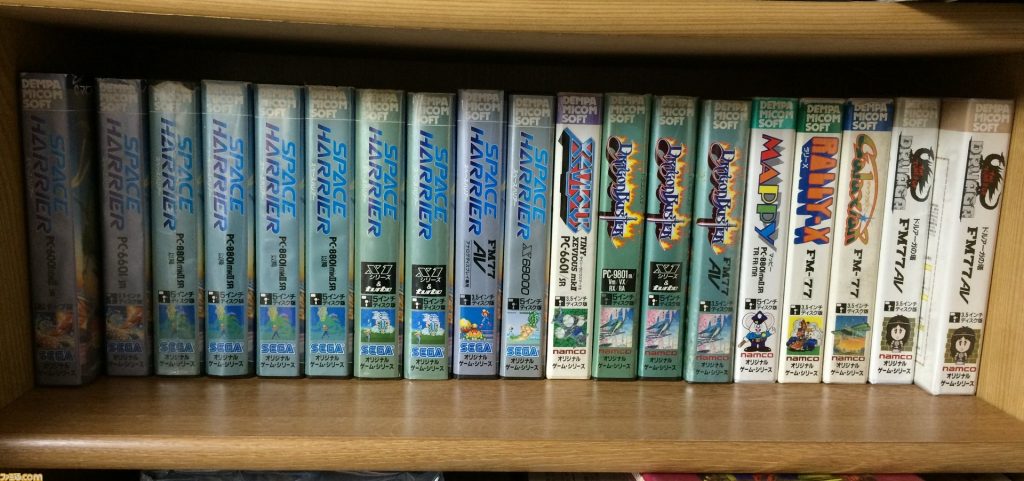
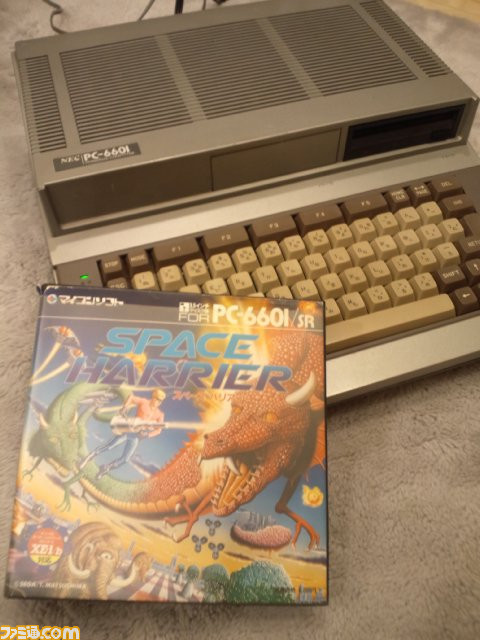 This is my old PC setup and game collection. I’ve got PC-9801DO+, FM-TOWNS, X68000, and PC-6601 machines. I also have FM-77AV and X1 Turbo machines not shown in the photos.” (Photos and comments courtesy of Hideki Kamiya)
This is my old PC setup and game collection. I’ve got PC-9801DO+, FM-TOWNS, X68000, and PC-6601 machines. I also have FM-77AV and X1 Turbo machines not shown in the photos.” (Photos and comments courtesy of Hideki Kamiya)
Toyoda: Do you have a goal in mind?
HK: I’m less of a “collector” than I am just playing what I want to play, so it’s less of a goal, and more of something that I’d like to emphasize to game creators. I want people to make more spaces like Virtual Console and Arcade Archives where the original creators of the past can properly benefit, and that we have a world where all games can properly archived.
YK: Ending on a high note. (Laughs)
HK: Seriously, and this is something I’ve said over and over again but even though we should be keeping game culture alive and passing it down, the old games just disappear as time passes, and it shows how immature the industry is. After becoming a creator myself and seeing young men and women come in who’ve never seen or played the old games, and don’t have a way to play them even if they wanted to, it makes me feel like the necessary connections aren’t being made. Creators should know and play the old games, at least those that are fairly well known. It’s not like I’ve played everything, but when you have some knowledge you can put it to use and say, “Let’s make this kind of game.” Actually, my brother has bought all of the Arcade Archives games.
YK: I was still young in the 80s and I’m not that familiar with all of the games, but there are many that are simple and easy to play, they load and retry quickly, and are great for playing quickly in an otherwise busy daily life.
HK: He’s played a lot, and he’s better than me at a few of them, which actually makes me happy. I think the core of what makes games fun hasn’t changed, and I think the world should be one where it’s easy for anyone to try that out for themselves.
Toyoda: It’s easy enough to see old movies, read old books, and listen to old songs, but if you want to play old games you need the equipment…
HK: And it’s not there. Even with the digital future, I think there needs to be more effort. To me, the games that I’ve grown up loving are still viable, not just sepia-toned memories. They shouldn’t become just memories, and that’s why I don’t want to call them “retro games.” With respect, I call them “old games” or “classic games.”
Well, this interview ended on something of a grandiose note, but how was it? I feel like I was the only one talking.
YK: Just like always. (Laughs)
Finally, we end with some additional photos and comments from Mr. Kamiya, where you can see the brotherly love shining through.
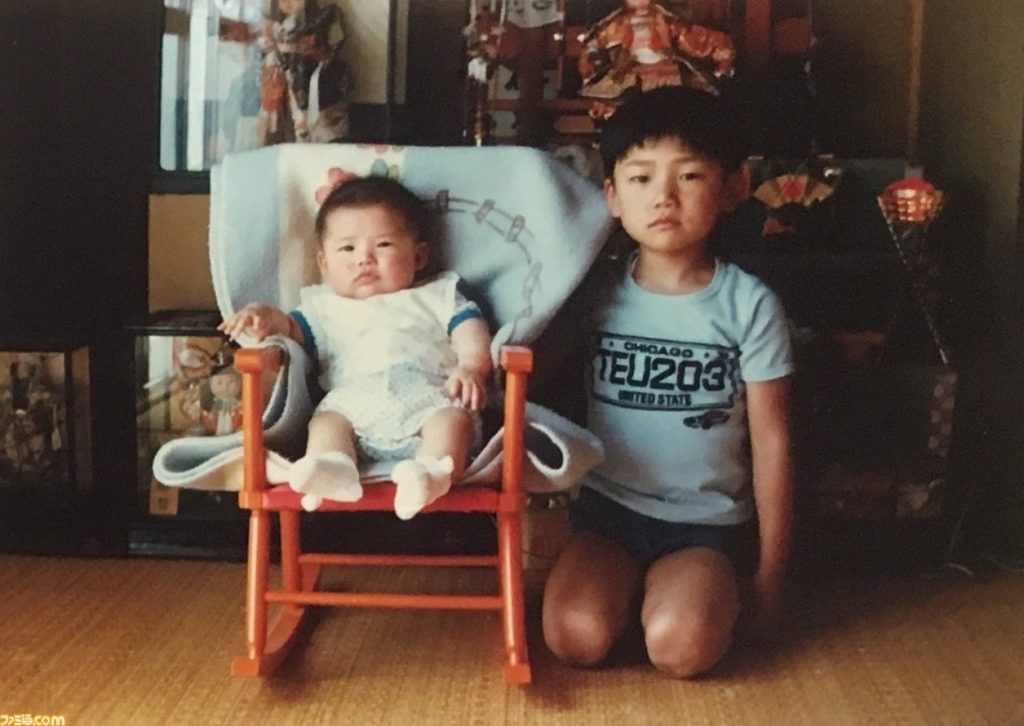 This is a photo of us when I was 7 and my brother was 1. It’s taken in our dad’s room, so the spot just behind me would be where the television and NES would go.
This is a photo of us when I was 7 and my brother was 1. It’s taken in our dad’s room, so the spot just behind me would be where the television and NES would go.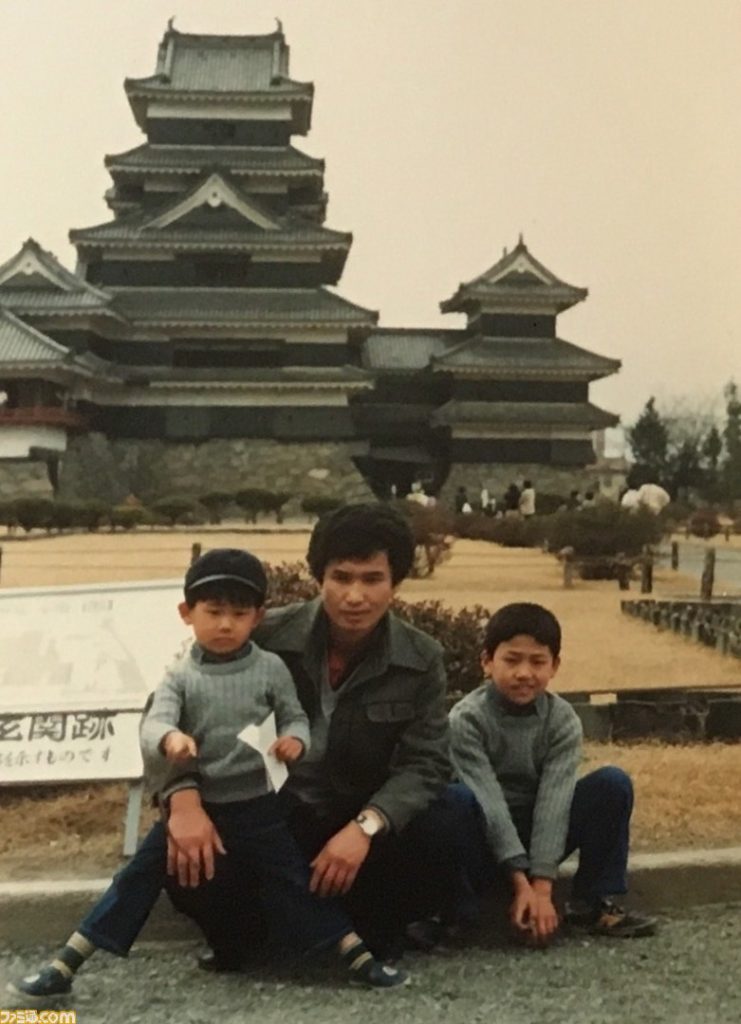
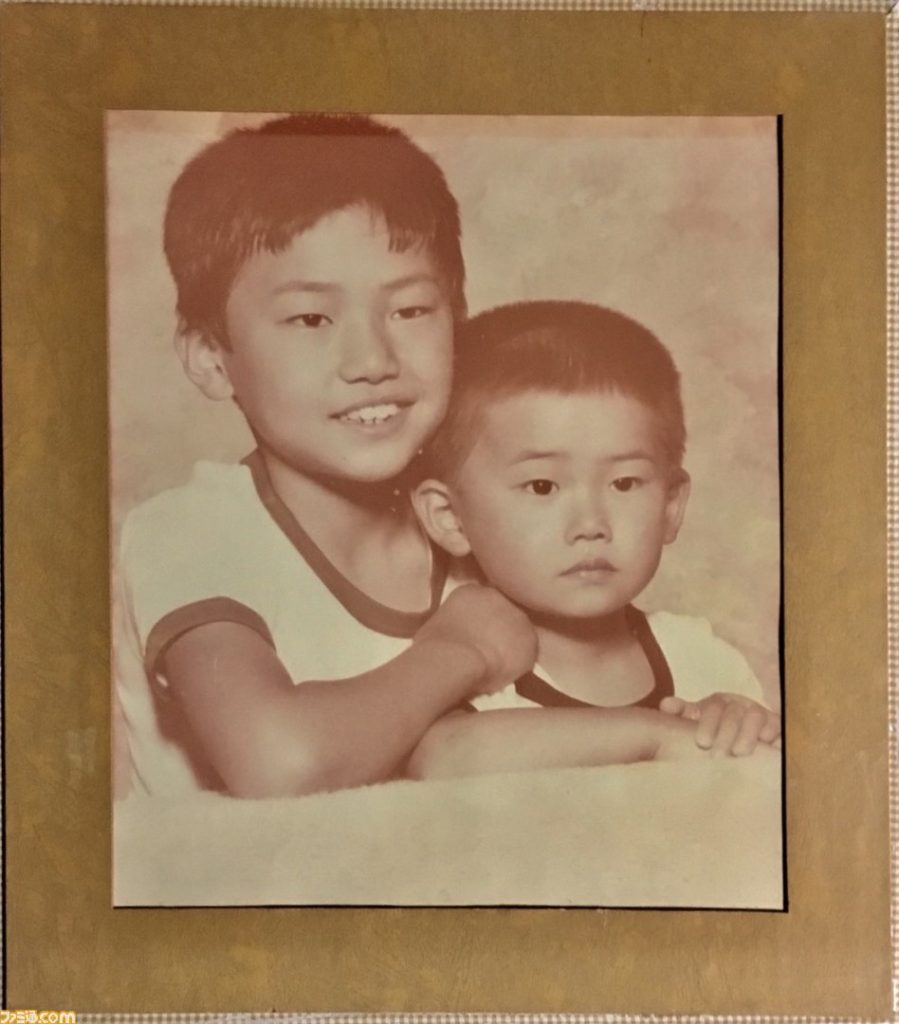 This was when I was 10 and my brother was 4. I think this was around the time TV Vader was released.
This was when I was 10 and my brother was 4. I think this was around the time TV Vader was released.
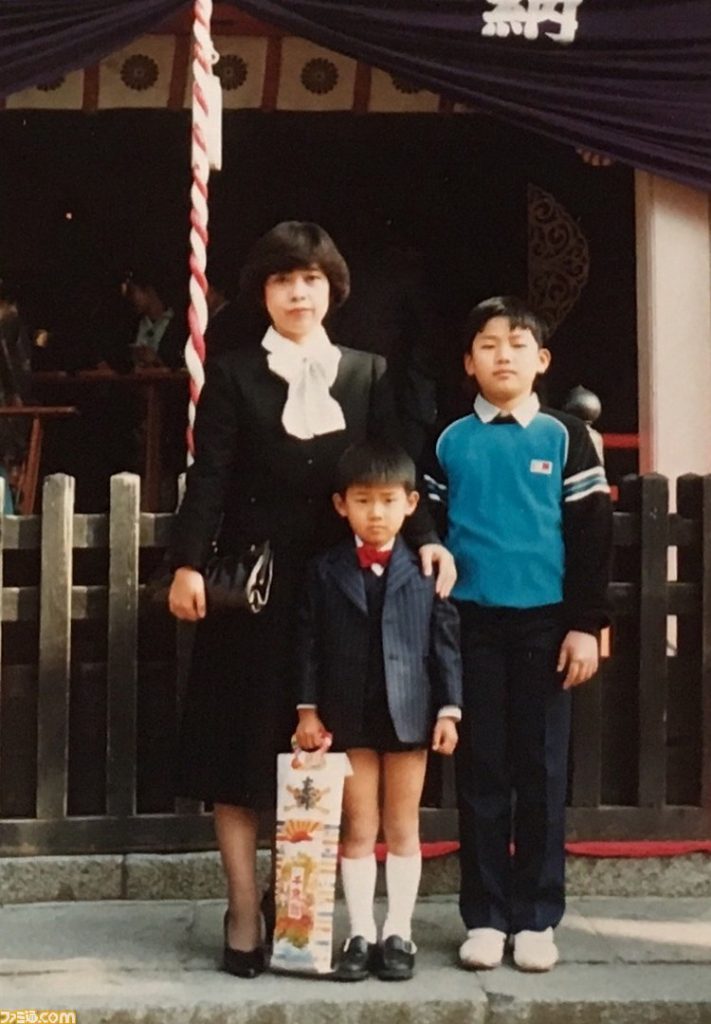 This was when I was 11 and my brother was 5. I was really into Cassette Vision.
This was when I was 11 and my brother was 5. I was really into Cassette Vision.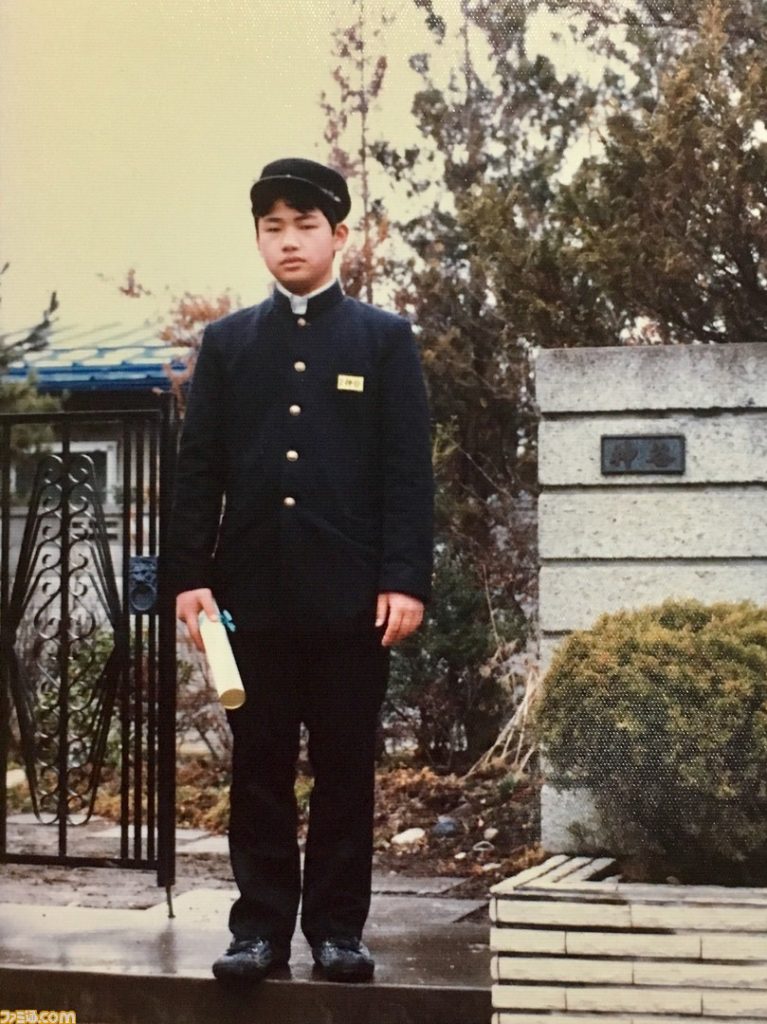 This is my junior high graduation photo. Right after this, I failed my high school entrance exam.
This is my junior high graduation photo. Right after this, I failed my high school entrance exam.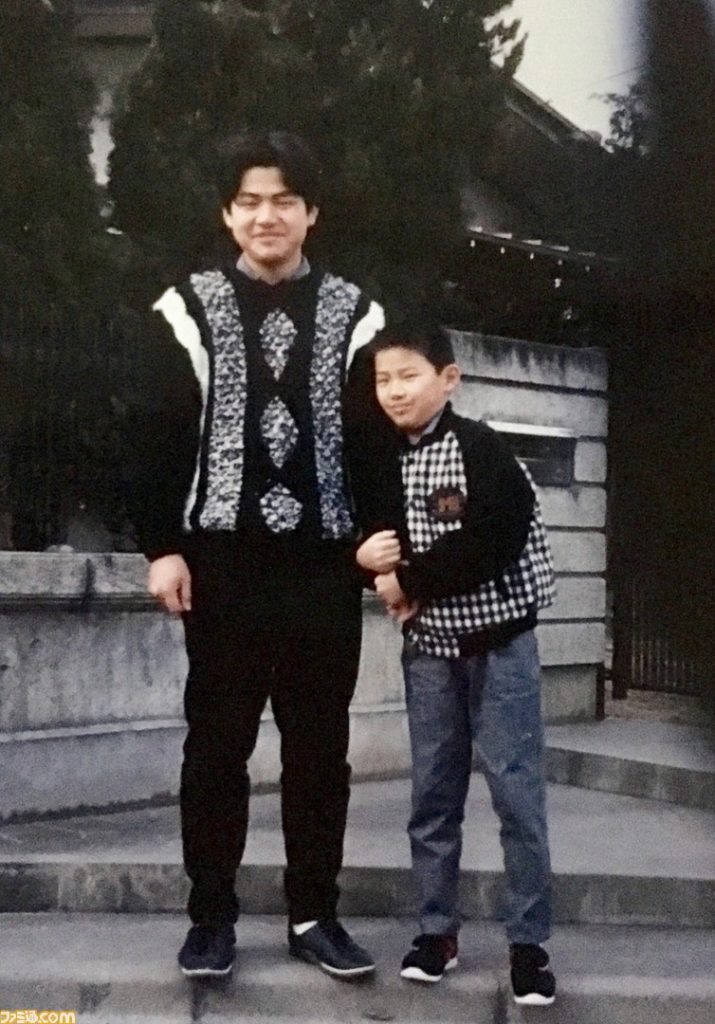 This was when I was a high school senior, and my brother had just started junior high school. I had stopped buying new consoles after the NES and Master System, and was mainly focused on the PC-8801.
This was when I was a high school senior, and my brother had just started junior high school. I had stopped buying new consoles after the NES and Master System, and was mainly focused on the PC-8801.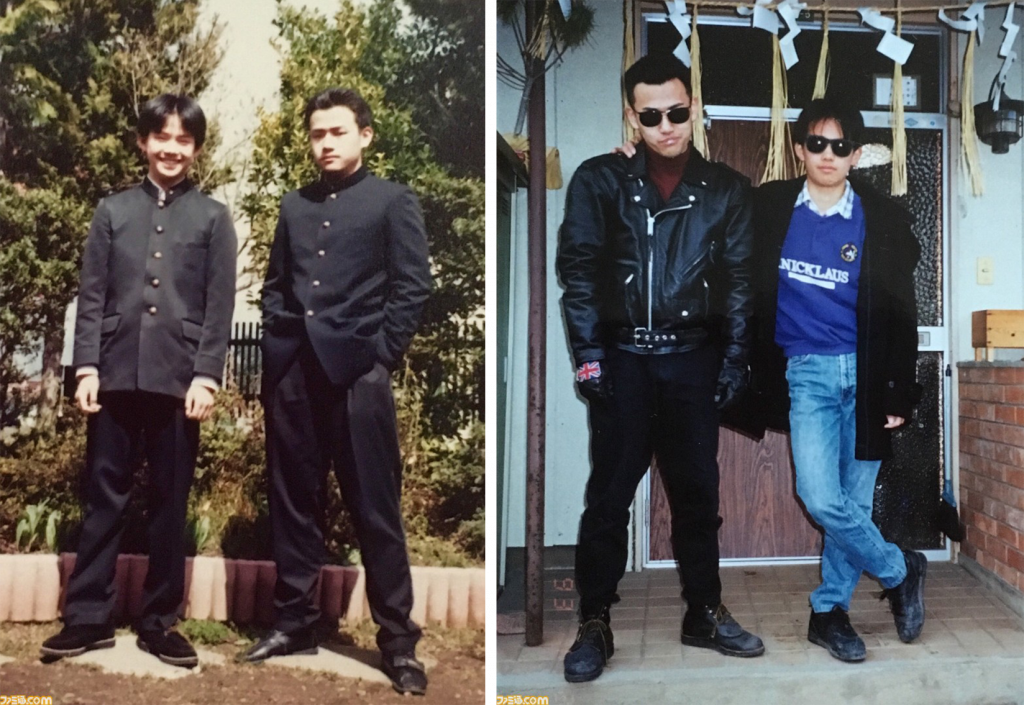 The photo on the left was taken when my brother started high school (I was in university then, but borrowed a uniform from him to take the photo). I think it was around the time he bought an X6800. The photo on the right is from just before my university graduation.
The photo on the left was taken when my brother started high school (I was in university then, but borrowed a uniform from him to take the photo). I think it was around the time he bought an X6800. The photo on the right is from just before my university graduation.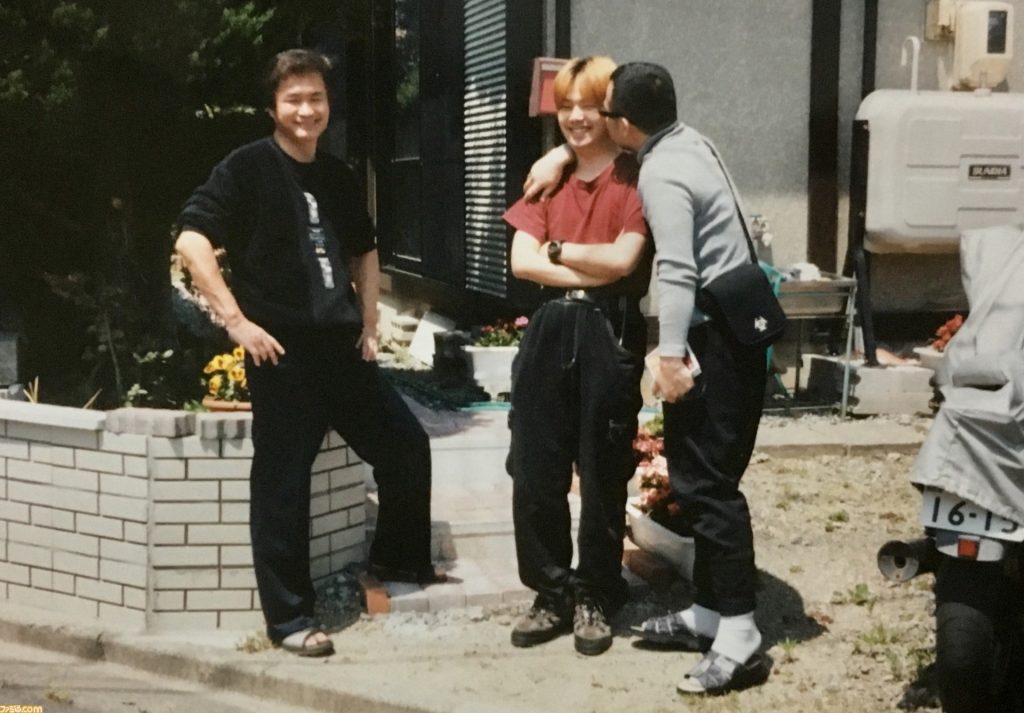 This photo was taken around the end of working on Resident Evil 2. I think this was also when my grown-up brother was killing me in Tetris Attack.
This photo was taken around the end of working on Resident Evil 2. I think this was also when my grown-up brother was killing me in Tetris Attack.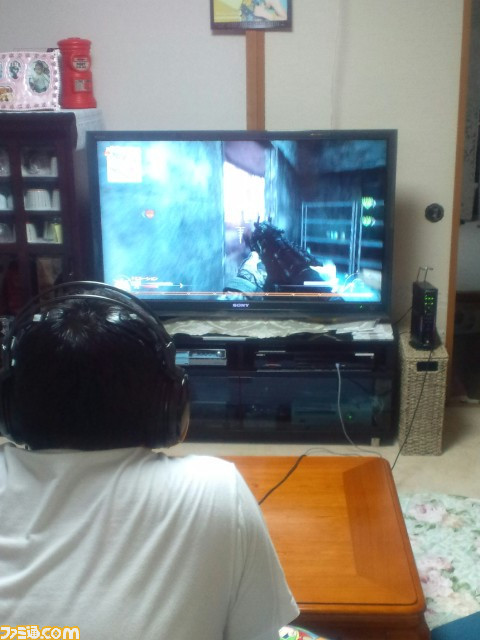 This is a photo I took of my brother a few years ago at our parents’ house. He was playing first-person shooters like this the whole time.
This is a photo I took of my brother a few years ago at our parents’ house. He was playing first-person shooters like this the whole time.